Managerial Economics
VerifiedAdded on 2023/04/25
|29
|5345
|61
AI Summary
This document covers various topics related to Managerial Economics such as supply schedule, factors affecting supply, degrees of elasticity of demand, point elasticity method and more. It explains the concept of supply schedule, individual and market supply schedule, factors affecting supply, and the degree of elasticity of demand. It also covers the point elasticity method and the formula for price elasticity of demand in terms of point elasticity of demand.
Contribute Materials
Your contribution can guide someone’s learning journey. Share your
documents today.
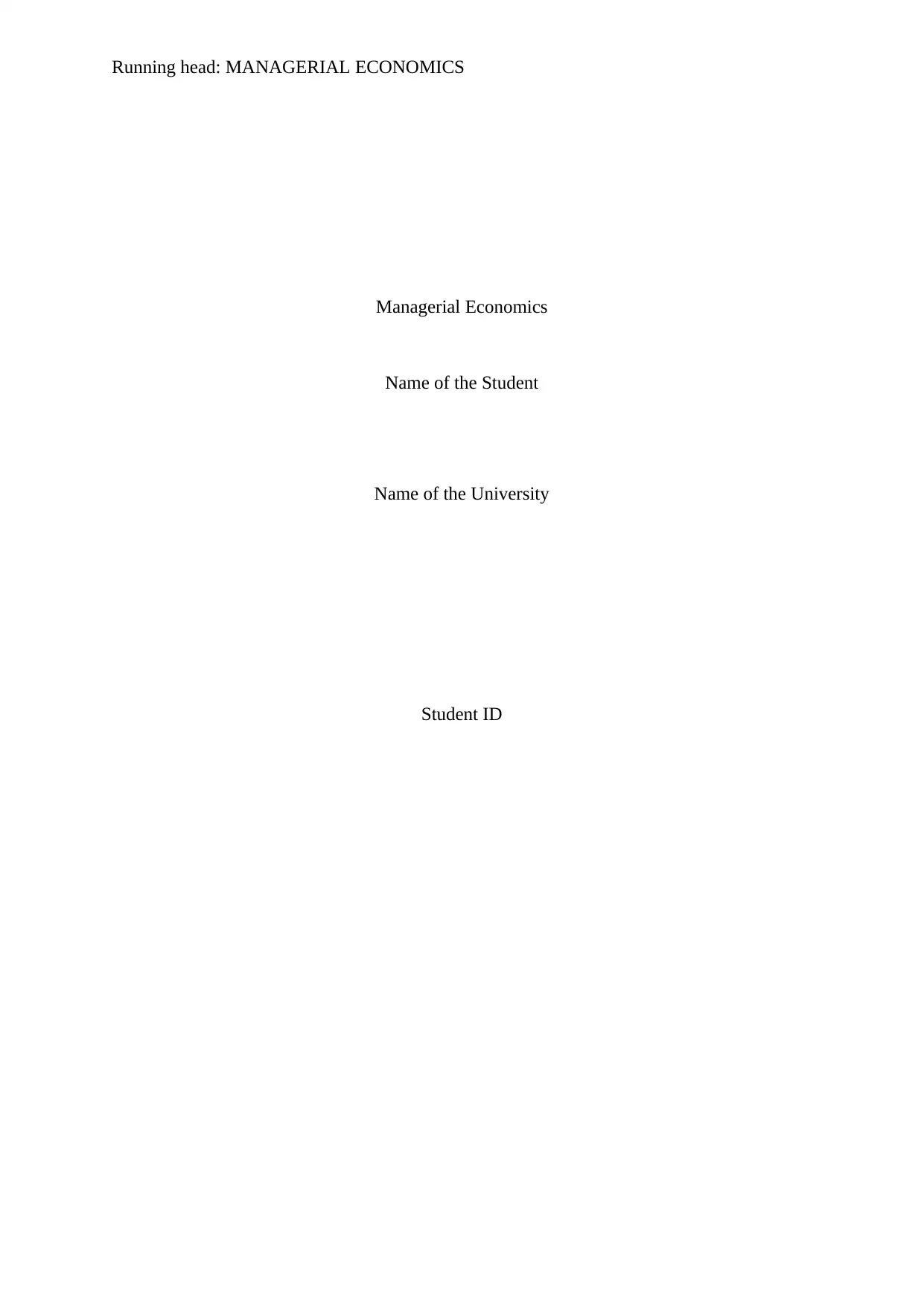
Running head: MANAGERIAL ECONOMICS
Managerial Economics
Name of the Student
Name of the University
Student ID
Managerial Economics
Name of the Student
Name of the University
Student ID
Secure Best Marks with AI Grader
Need help grading? Try our AI Grader for instant feedback on your assignments.
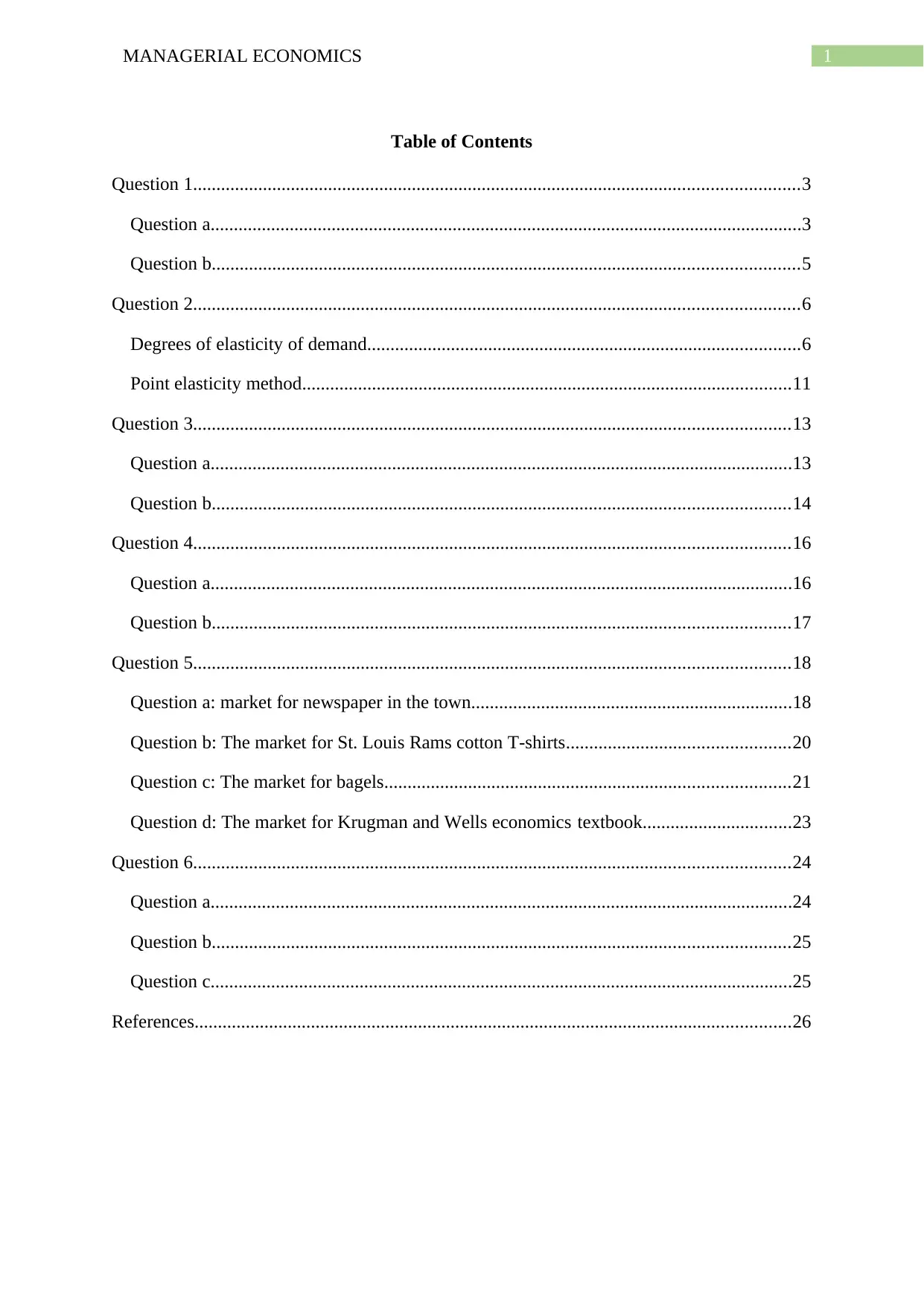
1MANAGERIAL ECONOMICS
Table of Contents
Question 1..................................................................................................................................3
Question a...............................................................................................................................3
Question b..............................................................................................................................5
Question 2..................................................................................................................................6
Degrees of elasticity of demand.............................................................................................6
Point elasticity method.........................................................................................................11
Question 3................................................................................................................................13
Question a.............................................................................................................................13
Question b............................................................................................................................14
Question 4................................................................................................................................16
Question a.............................................................................................................................16
Question b............................................................................................................................17
Question 5................................................................................................................................18
Question a: market for newspaper in the town.....................................................................18
Question b: The market for St. Louis Rams cotton T-shirts................................................20
Question c: The market for bagels.......................................................................................21
Question d: The market for Krugman and Wells economics textbook................................23
Question 6................................................................................................................................24
Question a.............................................................................................................................24
Question b............................................................................................................................25
Question c.............................................................................................................................25
References................................................................................................................................26
Table of Contents
Question 1..................................................................................................................................3
Question a...............................................................................................................................3
Question b..............................................................................................................................5
Question 2..................................................................................................................................6
Degrees of elasticity of demand.............................................................................................6
Point elasticity method.........................................................................................................11
Question 3................................................................................................................................13
Question a.............................................................................................................................13
Question b............................................................................................................................14
Question 4................................................................................................................................16
Question a.............................................................................................................................16
Question b............................................................................................................................17
Question 5................................................................................................................................18
Question a: market for newspaper in the town.....................................................................18
Question b: The market for St. Louis Rams cotton T-shirts................................................20
Question c: The market for bagels.......................................................................................21
Question d: The market for Krugman and Wells economics textbook................................23
Question 6................................................................................................................................24
Question a.............................................................................................................................24
Question b............................................................................................................................25
Question c.............................................................................................................................25
References................................................................................................................................26
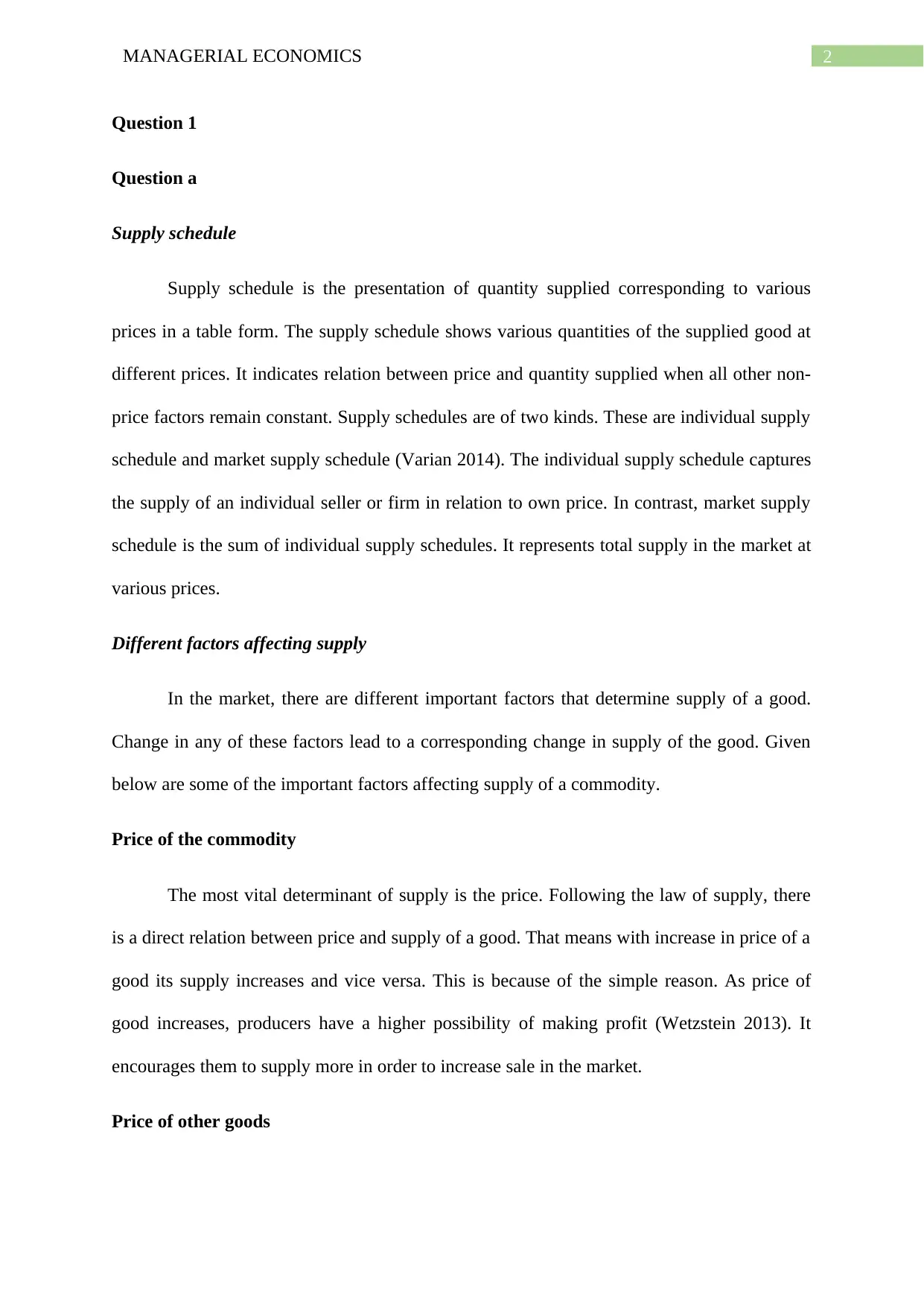
2MANAGERIAL ECONOMICS
Question 1
Question a
Supply schedule
Supply schedule is the presentation of quantity supplied corresponding to various
prices in a table form. The supply schedule shows various quantities of the supplied good at
different prices. It indicates relation between price and quantity supplied when all other non-
price factors remain constant. Supply schedules are of two kinds. These are individual supply
schedule and market supply schedule (Varian 2014). The individual supply schedule captures
the supply of an individual seller or firm in relation to own price. In contrast, market supply
schedule is the sum of individual supply schedules. It represents total supply in the market at
various prices.
Different factors affecting supply
In the market, there are different important factors that determine supply of a good.
Change in any of these factors lead to a corresponding change in supply of the good. Given
below are some of the important factors affecting supply of a commodity.
Price of the commodity
The most vital determinant of supply is the price. Following the law of supply, there
is a direct relation between price and supply of a good. That means with increase in price of a
good its supply increases and vice versa. This is because of the simple reason. As price of
good increases, producers have a higher possibility of making profit (Wetzstein 2013). It
encourages them to supply more in order to increase sale in the market.
Price of other goods
Question 1
Question a
Supply schedule
Supply schedule is the presentation of quantity supplied corresponding to various
prices in a table form. The supply schedule shows various quantities of the supplied good at
different prices. It indicates relation between price and quantity supplied when all other non-
price factors remain constant. Supply schedules are of two kinds. These are individual supply
schedule and market supply schedule (Varian 2014). The individual supply schedule captures
the supply of an individual seller or firm in relation to own price. In contrast, market supply
schedule is the sum of individual supply schedules. It represents total supply in the market at
various prices.
Different factors affecting supply
In the market, there are different important factors that determine supply of a good.
Change in any of these factors lead to a corresponding change in supply of the good. Given
below are some of the important factors affecting supply of a commodity.
Price of the commodity
The most vital determinant of supply is the price. Following the law of supply, there
is a direct relation between price and supply of a good. That means with increase in price of a
good its supply increases and vice versa. This is because of the simple reason. As price of
good increases, producers have a higher possibility of making profit (Wetzstein 2013). It
encourages them to supply more in order to increase sale in the market.
Price of other goods
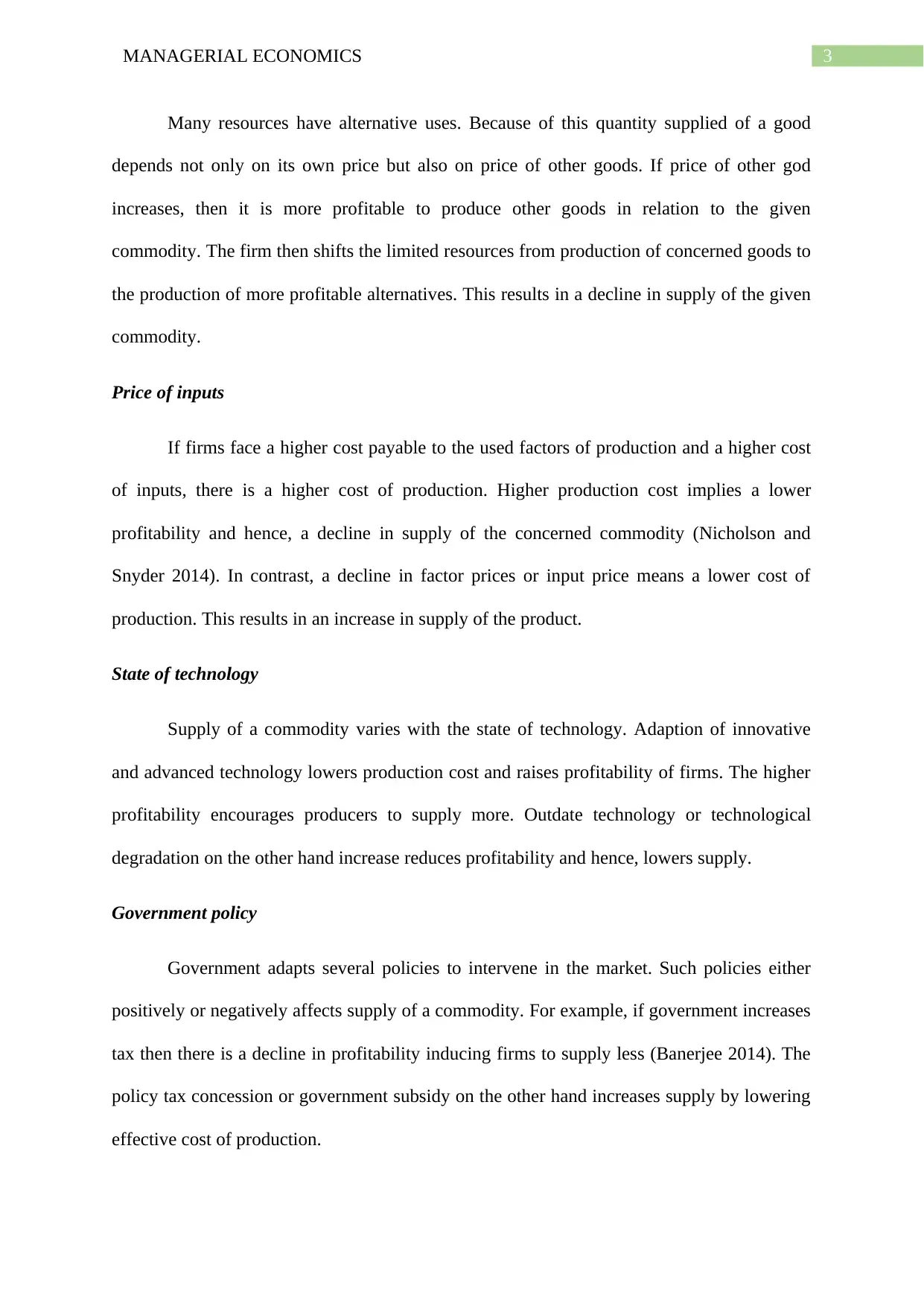
3MANAGERIAL ECONOMICS
Many resources have alternative uses. Because of this quantity supplied of a good
depends not only on its own price but also on price of other goods. If price of other god
increases, then it is more profitable to produce other goods in relation to the given
commodity. The firm then shifts the limited resources from production of concerned goods to
the production of more profitable alternatives. This results in a decline in supply of the given
commodity.
Price of inputs
If firms face a higher cost payable to the used factors of production and a higher cost
of inputs, there is a higher cost of production. Higher production cost implies a lower
profitability and hence, a decline in supply of the concerned commodity (Nicholson and
Snyder 2014). In contrast, a decline in factor prices or input price means a lower cost of
production. This results in an increase in supply of the product.
State of technology
Supply of a commodity varies with the state of technology. Adaption of innovative
and advanced technology lowers production cost and raises profitability of firms. The higher
profitability encourages producers to supply more. Outdate technology or technological
degradation on the other hand increase reduces profitability and hence, lowers supply.
Government policy
Government adapts several policies to intervene in the market. Such policies either
positively or negatively affects supply of a commodity. For example, if government increases
tax then there is a decline in profitability inducing firms to supply less (Banerjee 2014). The
policy tax concession or government subsidy on the other hand increases supply by lowering
effective cost of production.
Many resources have alternative uses. Because of this quantity supplied of a good
depends not only on its own price but also on price of other goods. If price of other god
increases, then it is more profitable to produce other goods in relation to the given
commodity. The firm then shifts the limited resources from production of concerned goods to
the production of more profitable alternatives. This results in a decline in supply of the given
commodity.
Price of inputs
If firms face a higher cost payable to the used factors of production and a higher cost
of inputs, there is a higher cost of production. Higher production cost implies a lower
profitability and hence, a decline in supply of the concerned commodity (Nicholson and
Snyder 2014). In contrast, a decline in factor prices or input price means a lower cost of
production. This results in an increase in supply of the product.
State of technology
Supply of a commodity varies with the state of technology. Adaption of innovative
and advanced technology lowers production cost and raises profitability of firms. The higher
profitability encourages producers to supply more. Outdate technology or technological
degradation on the other hand increase reduces profitability and hence, lowers supply.
Government policy
Government adapts several policies to intervene in the market. Such policies either
positively or negatively affects supply of a commodity. For example, if government increases
tax then there is a decline in profitability inducing firms to supply less (Banerjee 2014). The
policy tax concession or government subsidy on the other hand increases supply by lowering
effective cost of production.
Secure Best Marks with AI Grader
Need help grading? Try our AI Grader for instant feedback on your assignments.
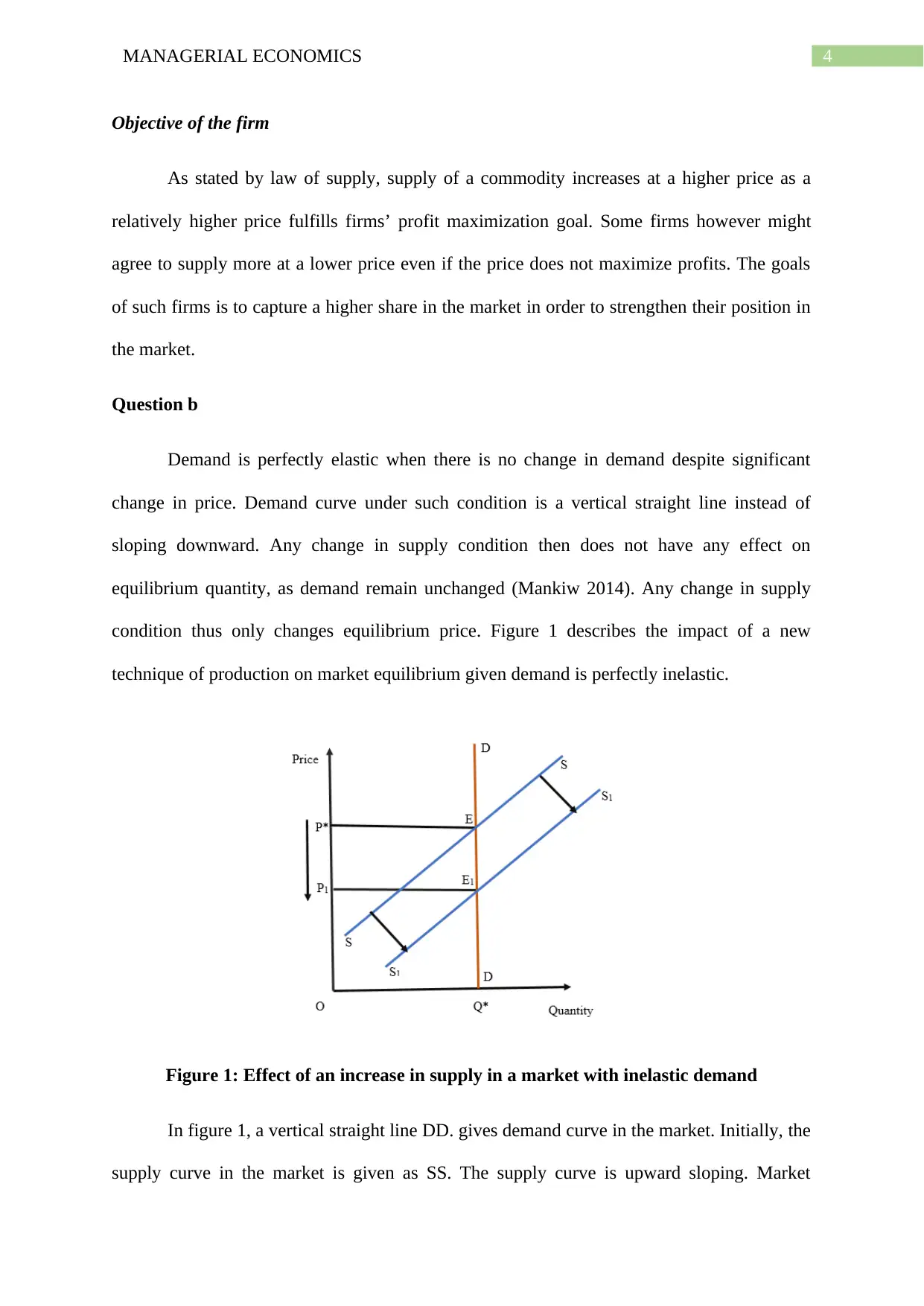
4MANAGERIAL ECONOMICS
Objective of the firm
As stated by law of supply, supply of a commodity increases at a higher price as a
relatively higher price fulfills firms’ profit maximization goal. Some firms however might
agree to supply more at a lower price even if the price does not maximize profits. The goals
of such firms is to capture a higher share in the market in order to strengthen their position in
the market.
Question b
Demand is perfectly elastic when there is no change in demand despite significant
change in price. Demand curve under such condition is a vertical straight line instead of
sloping downward. Any change in supply condition then does not have any effect on
equilibrium quantity, as demand remain unchanged (Mankiw 2014). Any change in supply
condition thus only changes equilibrium price. Figure 1 describes the impact of a new
technique of production on market equilibrium given demand is perfectly inelastic.
Figure 1: Effect of an increase in supply in a market with inelastic demand
In figure 1, a vertical straight line DD. gives demand curve in the market. Initially, the
supply curve in the market is given as SS. The supply curve is upward sloping. Market
Objective of the firm
As stated by law of supply, supply of a commodity increases at a higher price as a
relatively higher price fulfills firms’ profit maximization goal. Some firms however might
agree to supply more at a lower price even if the price does not maximize profits. The goals
of such firms is to capture a higher share in the market in order to strengthen their position in
the market.
Question b
Demand is perfectly elastic when there is no change in demand despite significant
change in price. Demand curve under such condition is a vertical straight line instead of
sloping downward. Any change in supply condition then does not have any effect on
equilibrium quantity, as demand remain unchanged (Mankiw 2014). Any change in supply
condition thus only changes equilibrium price. Figure 1 describes the impact of a new
technique of production on market equilibrium given demand is perfectly inelastic.
Figure 1: Effect of an increase in supply in a market with inelastic demand
In figure 1, a vertical straight line DD. gives demand curve in the market. Initially, the
supply curve in the market is given as SS. The supply curve is upward sloping. Market
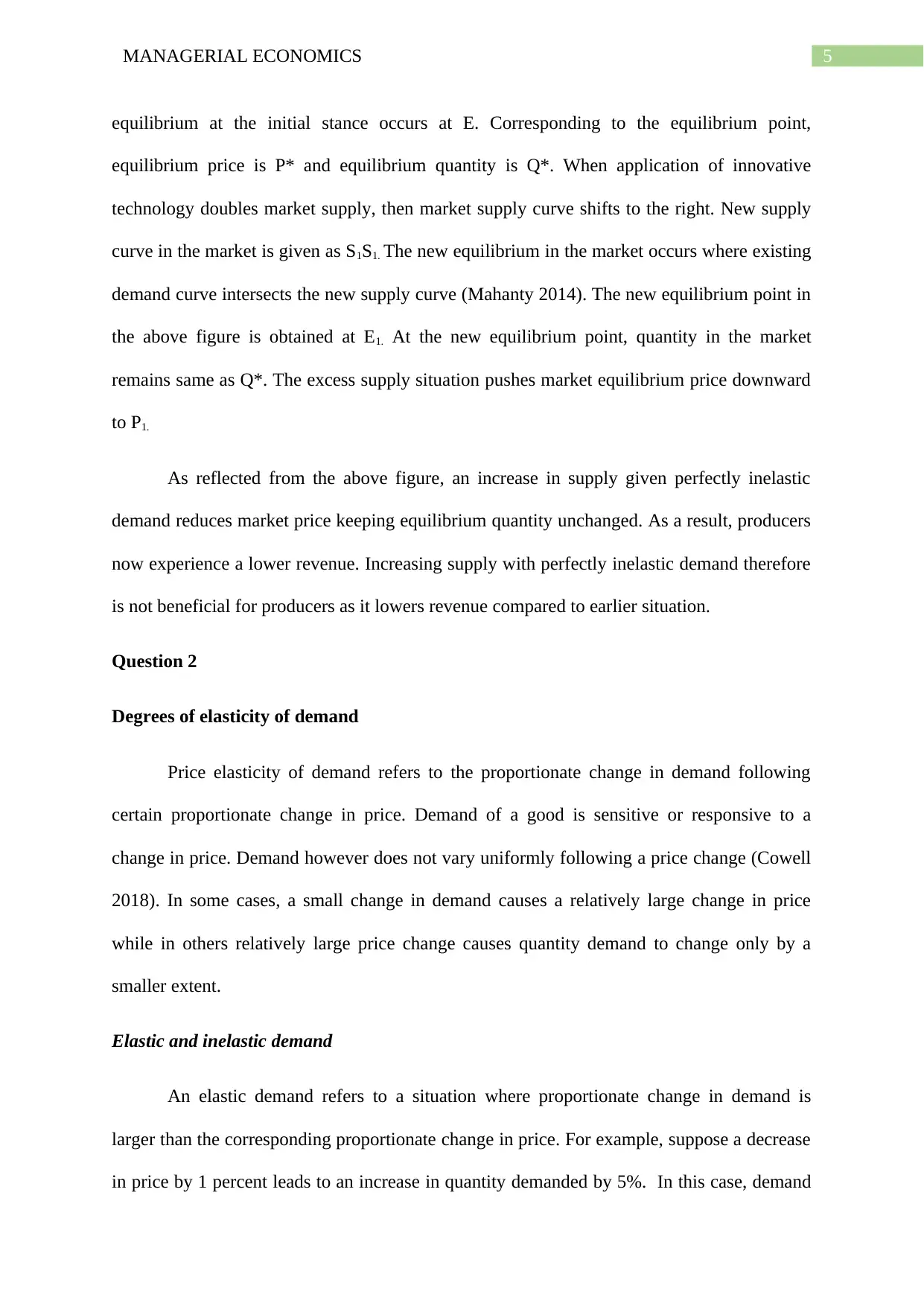
5MANAGERIAL ECONOMICS
equilibrium at the initial stance occurs at E. Corresponding to the equilibrium point,
equilibrium price is P* and equilibrium quantity is Q*. When application of innovative
technology doubles market supply, then market supply curve shifts to the right. New supply
curve in the market is given as S1S1. The new equilibrium in the market occurs where existing
demand curve intersects the new supply curve (Mahanty 2014). The new equilibrium point in
the above figure is obtained at E1. At the new equilibrium point, quantity in the market
remains same as Q*. The excess supply situation pushes market equilibrium price downward
to P1.
As reflected from the above figure, an increase in supply given perfectly inelastic
demand reduces market price keeping equilibrium quantity unchanged. As a result, producers
now experience a lower revenue. Increasing supply with perfectly inelastic demand therefore
is not beneficial for producers as it lowers revenue compared to earlier situation.
Question 2
Degrees of elasticity of demand
Price elasticity of demand refers to the proportionate change in demand following
certain proportionate change in price. Demand of a good is sensitive or responsive to a
change in price. Demand however does not vary uniformly following a price change (Cowell
2018). In some cases, a small change in demand causes a relatively large change in price
while in others relatively large price change causes quantity demand to change only by a
smaller extent.
Elastic and inelastic demand
An elastic demand refers to a situation where proportionate change in demand is
larger than the corresponding proportionate change in price. For example, suppose a decrease
in price by 1 percent leads to an increase in quantity demanded by 5%. In this case, demand
equilibrium at the initial stance occurs at E. Corresponding to the equilibrium point,
equilibrium price is P* and equilibrium quantity is Q*. When application of innovative
technology doubles market supply, then market supply curve shifts to the right. New supply
curve in the market is given as S1S1. The new equilibrium in the market occurs where existing
demand curve intersects the new supply curve (Mahanty 2014). The new equilibrium point in
the above figure is obtained at E1. At the new equilibrium point, quantity in the market
remains same as Q*. The excess supply situation pushes market equilibrium price downward
to P1.
As reflected from the above figure, an increase in supply given perfectly inelastic
demand reduces market price keeping equilibrium quantity unchanged. As a result, producers
now experience a lower revenue. Increasing supply with perfectly inelastic demand therefore
is not beneficial for producers as it lowers revenue compared to earlier situation.
Question 2
Degrees of elasticity of demand
Price elasticity of demand refers to the proportionate change in demand following
certain proportionate change in price. Demand of a good is sensitive or responsive to a
change in price. Demand however does not vary uniformly following a price change (Cowell
2018). In some cases, a small change in demand causes a relatively large change in price
while in others relatively large price change causes quantity demand to change only by a
smaller extent.
Elastic and inelastic demand
An elastic demand refers to a situation where proportionate change in demand is
larger than the corresponding proportionate change in price. For example, suppose a decrease
in price by 1 percent leads to an increase in quantity demanded by 5%. In this case, demand
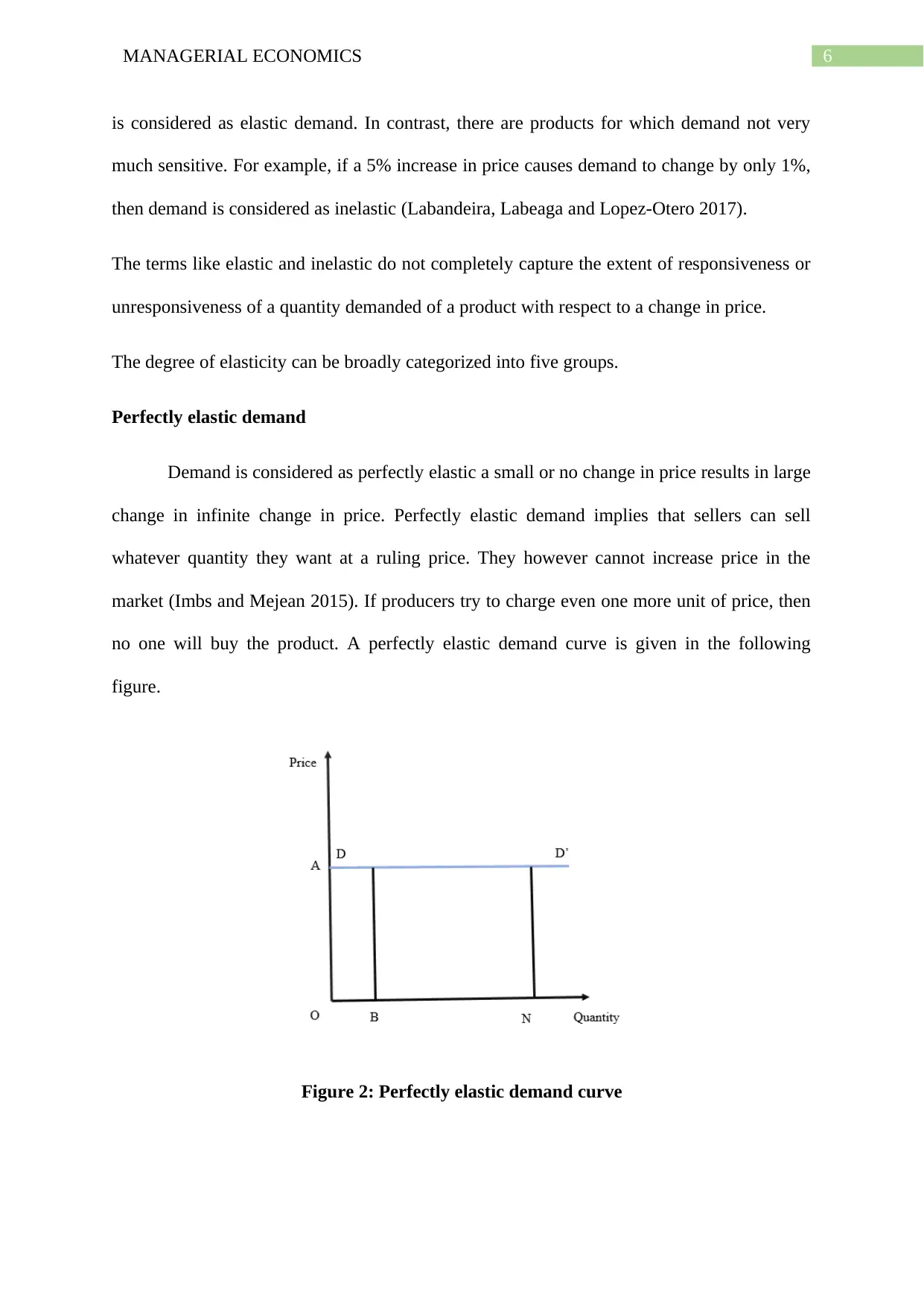
6MANAGERIAL ECONOMICS
is considered as elastic demand. In contrast, there are products for which demand not very
much sensitive. For example, if a 5% increase in price causes demand to change by only 1%,
then demand is considered as inelastic (Labandeira, Labeaga and Lopez-Otero 2017).
The terms like elastic and inelastic do not completely capture the extent of responsiveness or
unresponsiveness of a quantity demanded of a product with respect to a change in price.
The degree of elasticity can be broadly categorized into five groups.
Perfectly elastic demand
Demand is considered as perfectly elastic a small or no change in price results in large
change in infinite change in price. Perfectly elastic demand implies that sellers can sell
whatever quantity they want at a ruling price. They however cannot increase price in the
market (Imbs and Mejean 2015). If producers try to charge even one more unit of price, then
no one will buy the product. A perfectly elastic demand curve is given in the following
figure.
Figure 2: Perfectly elastic demand curve
is considered as elastic demand. In contrast, there are products for which demand not very
much sensitive. For example, if a 5% increase in price causes demand to change by only 1%,
then demand is considered as inelastic (Labandeira, Labeaga and Lopez-Otero 2017).
The terms like elastic and inelastic do not completely capture the extent of responsiveness or
unresponsiveness of a quantity demanded of a product with respect to a change in price.
The degree of elasticity can be broadly categorized into five groups.
Perfectly elastic demand
Demand is considered as perfectly elastic a small or no change in price results in large
change in infinite change in price. Perfectly elastic demand implies that sellers can sell
whatever quantity they want at a ruling price. They however cannot increase price in the
market (Imbs and Mejean 2015). If producers try to charge even one more unit of price, then
no one will buy the product. A perfectly elastic demand curve is given in the following
figure.
Figure 2: Perfectly elastic demand curve
Paraphrase This Document
Need a fresh take? Get an instant paraphrase of this document with our AI Paraphraser
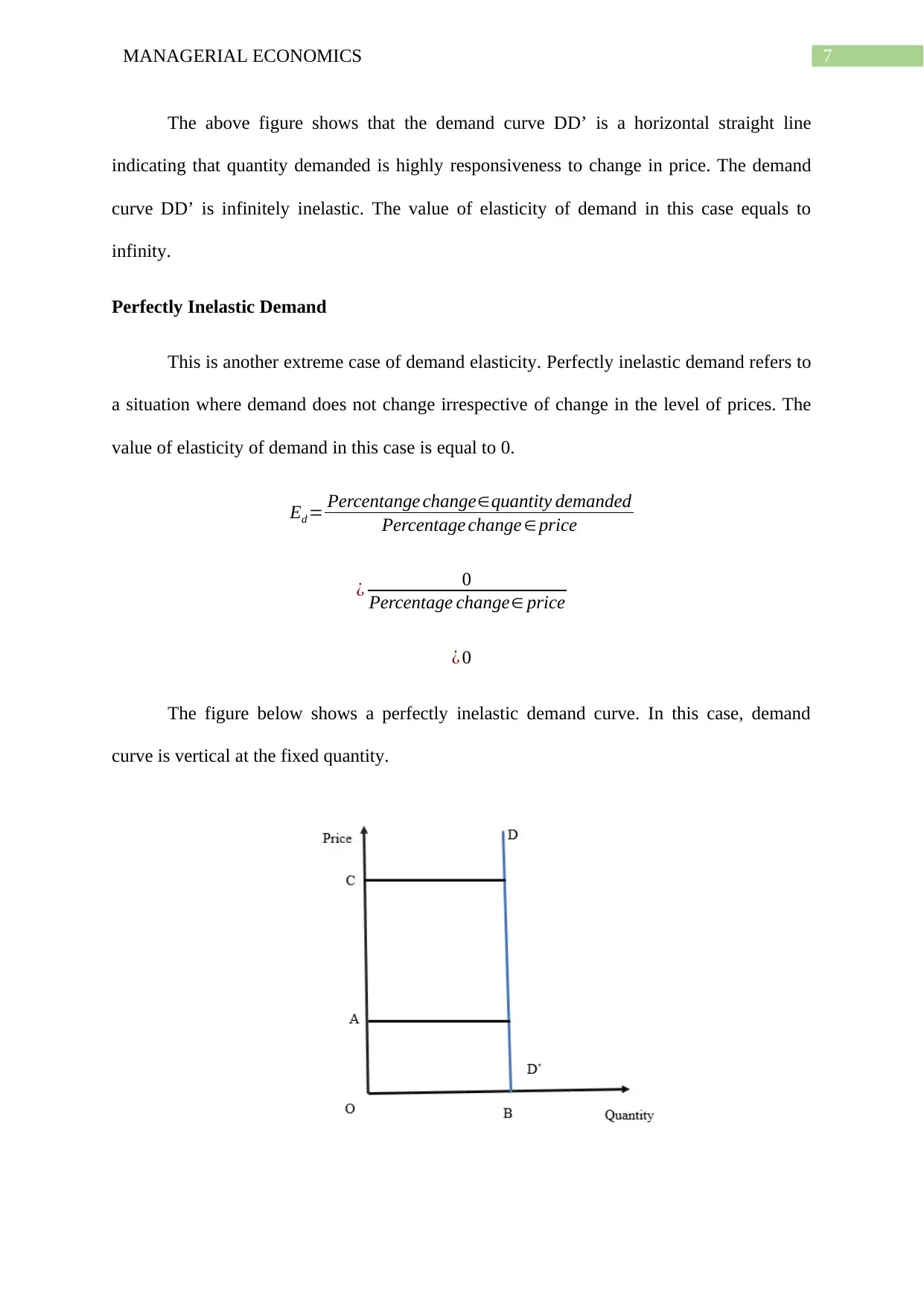
7MANAGERIAL ECONOMICS
The above figure shows that the demand curve DD’ is a horizontal straight line
indicating that quantity demanded is highly responsiveness to change in price. The demand
curve DD’ is infinitely inelastic. The value of elasticity of demand in this case equals to
infinity.
Perfectly Inelastic Demand
This is another extreme case of demand elasticity. Perfectly inelastic demand refers to
a situation where demand does not change irrespective of change in the level of prices. The
value of elasticity of demand in this case is equal to 0.
Ed = Percentange change∈quantity demanded
Percentage change ∈ price
¿ 0
Percentage change∈ price
¿ 0
The figure below shows a perfectly inelastic demand curve. In this case, demand
curve is vertical at the fixed quantity.
The above figure shows that the demand curve DD’ is a horizontal straight line
indicating that quantity demanded is highly responsiveness to change in price. The demand
curve DD’ is infinitely inelastic. The value of elasticity of demand in this case equals to
infinity.
Perfectly Inelastic Demand
This is another extreme case of demand elasticity. Perfectly inelastic demand refers to
a situation where demand does not change irrespective of change in the level of prices. The
value of elasticity of demand in this case is equal to 0.
Ed = Percentange change∈quantity demanded
Percentage change ∈ price
¿ 0
Percentage change∈ price
¿ 0
The figure below shows a perfectly inelastic demand curve. In this case, demand
curve is vertical at the fixed quantity.
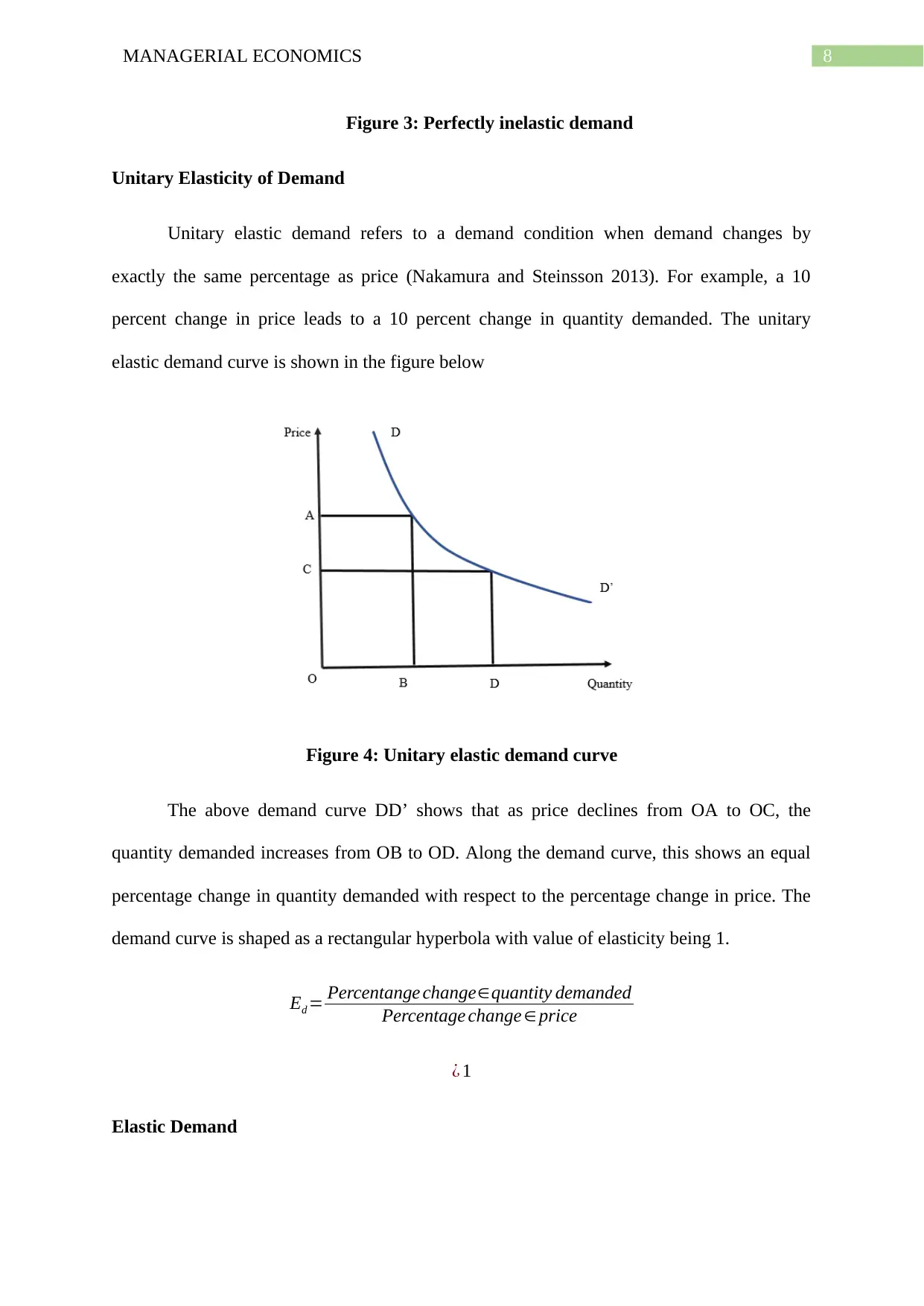
8MANAGERIAL ECONOMICS
Figure 3: Perfectly inelastic demand
Unitary Elasticity of Demand
Unitary elastic demand refers to a demand condition when demand changes by
exactly the same percentage as price (Nakamura and Steinsson 2013). For example, a 10
percent change in price leads to a 10 percent change in quantity demanded. The unitary
elastic demand curve is shown in the figure below
Figure 4: Unitary elastic demand curve
The above demand curve DD’ shows that as price declines from OA to OC, the
quantity demanded increases from OB to OD. Along the demand curve, this shows an equal
percentage change in quantity demanded with respect to the percentage change in price. The
demand curve is shaped as a rectangular hyperbola with value of elasticity being 1.
Ed = Percentange change∈quantity demanded
Percentage change ∈ price
¿ 1
Elastic Demand
Figure 3: Perfectly inelastic demand
Unitary Elasticity of Demand
Unitary elastic demand refers to a demand condition when demand changes by
exactly the same percentage as price (Nakamura and Steinsson 2013). For example, a 10
percent change in price leads to a 10 percent change in quantity demanded. The unitary
elastic demand curve is shown in the figure below
Figure 4: Unitary elastic demand curve
The above demand curve DD’ shows that as price declines from OA to OC, the
quantity demanded increases from OB to OD. Along the demand curve, this shows an equal
percentage change in quantity demanded with respect to the percentage change in price. The
demand curve is shaped as a rectangular hyperbola with value of elasticity being 1.
Ed = Percentange change∈quantity demanded
Percentage change ∈ price
¿ 1
Elastic Demand
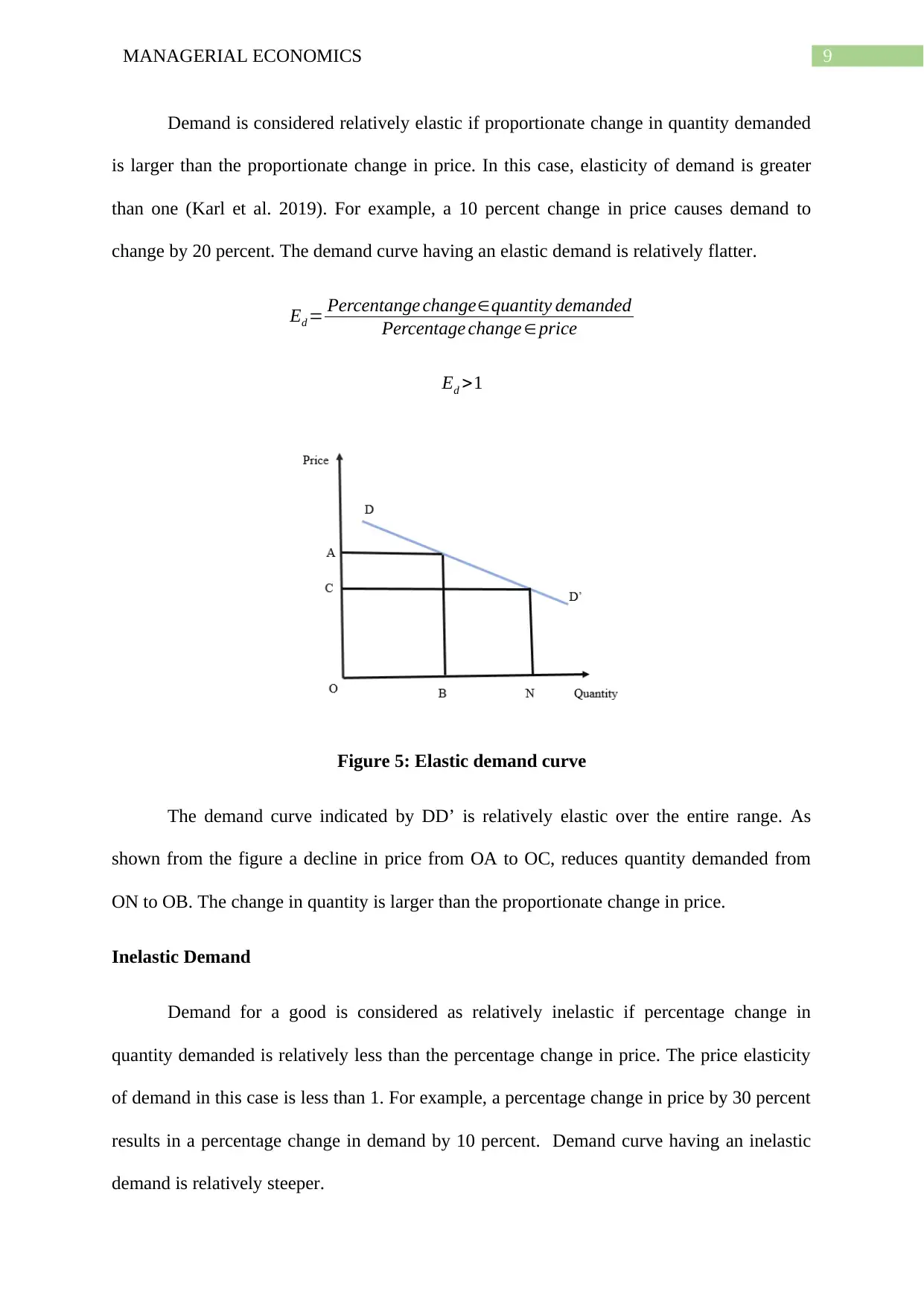
9MANAGERIAL ECONOMICS
Demand is considered relatively elastic if proportionate change in quantity demanded
is larger than the proportionate change in price. In this case, elasticity of demand is greater
than one (Karl et al. 2019). For example, a 10 percent change in price causes demand to
change by 20 percent. The demand curve having an elastic demand is relatively flatter.
Ed = Percentange change∈quantity demanded
Percentage change ∈ price
Ed >1
Figure 5: Elastic demand curve
The demand curve indicated by DD’ is relatively elastic over the entire range. As
shown from the figure a decline in price from OA to OC, reduces quantity demanded from
ON to OB. The change in quantity is larger than the proportionate change in price.
Inelastic Demand
Demand for a good is considered as relatively inelastic if percentage change in
quantity demanded is relatively less than the percentage change in price. The price elasticity
of demand in this case is less than 1. For example, a percentage change in price by 30 percent
results in a percentage change in demand by 10 percent. Demand curve having an inelastic
demand is relatively steeper.
Demand is considered relatively elastic if proportionate change in quantity demanded
is larger than the proportionate change in price. In this case, elasticity of demand is greater
than one (Karl et al. 2019). For example, a 10 percent change in price causes demand to
change by 20 percent. The demand curve having an elastic demand is relatively flatter.
Ed = Percentange change∈quantity demanded
Percentage change ∈ price
Ed >1
Figure 5: Elastic demand curve
The demand curve indicated by DD’ is relatively elastic over the entire range. As
shown from the figure a decline in price from OA to OC, reduces quantity demanded from
ON to OB. The change in quantity is larger than the proportionate change in price.
Inelastic Demand
Demand for a good is considered as relatively inelastic if percentage change in
quantity demanded is relatively less than the percentage change in price. The price elasticity
of demand in this case is less than 1. For example, a percentage change in price by 30 percent
results in a percentage change in demand by 10 percent. Demand curve having an inelastic
demand is relatively steeper.
Secure Best Marks with AI Grader
Need help grading? Try our AI Grader for instant feedback on your assignments.
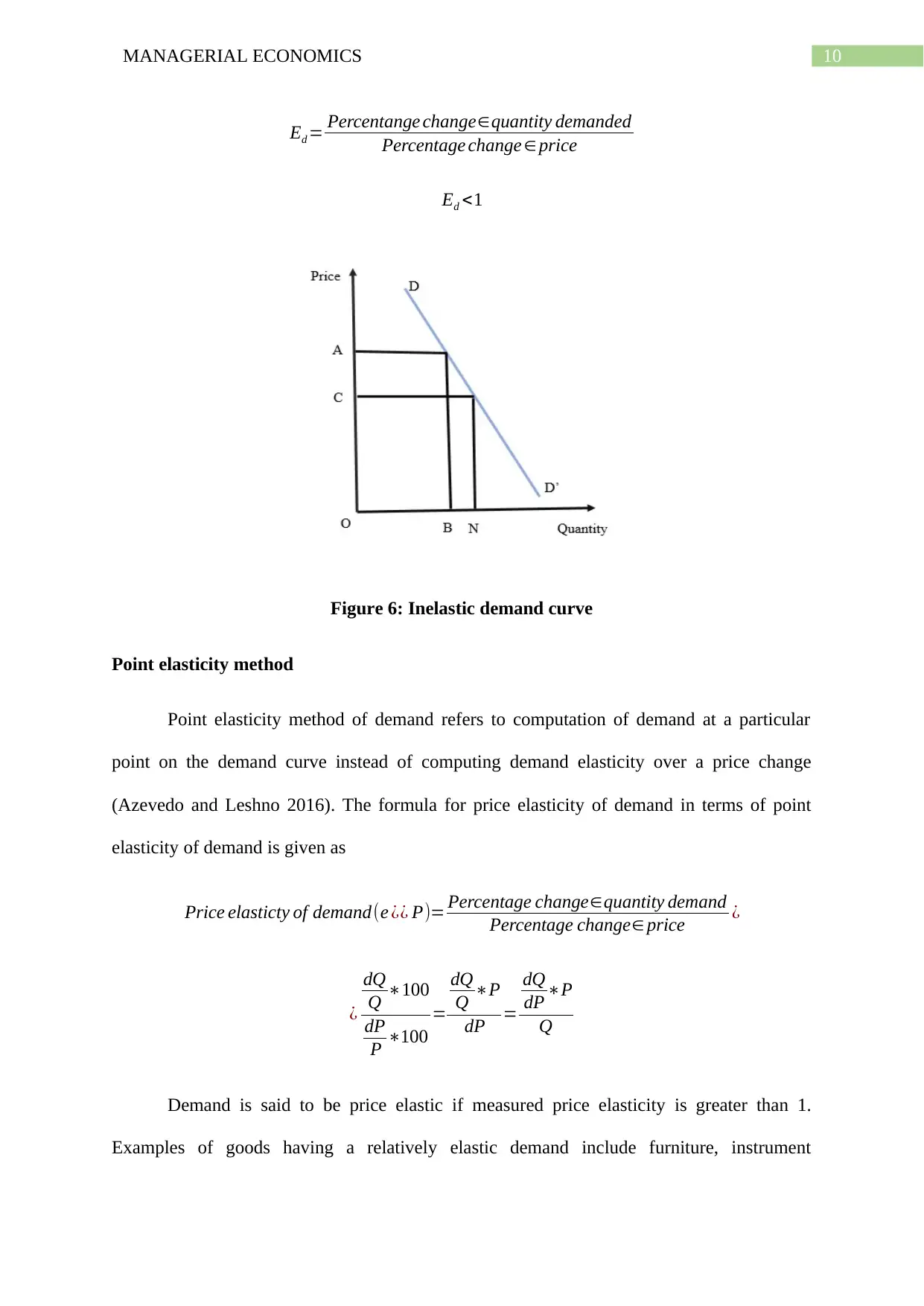
10MANAGERIAL ECONOMICS
Ed = Percentange change∈quantity demanded
Percentage change ∈ price
Ed <1
Figure 6: Inelastic demand curve
Point elasticity method
Point elasticity method of demand refers to computation of demand at a particular
point on the demand curve instead of computing demand elasticity over a price change
(Azevedo and Leshno 2016). The formula for price elasticity of demand in terms of point
elasticity of demand is given as
Price elasticty of demand(e ¿¿ P)= Percentage change∈quantity demand
Percentage change∈ price ¿
¿
dQ
Q ∗100
dP
P ∗100
=
dQ
Q ∗P
dP =
dQ
dP ∗P
Q
Demand is said to be price elastic if measured price elasticity is greater than 1.
Examples of goods having a relatively elastic demand include furniture, instrument
Ed = Percentange change∈quantity demanded
Percentage change ∈ price
Ed <1
Figure 6: Inelastic demand curve
Point elasticity method
Point elasticity method of demand refers to computation of demand at a particular
point on the demand curve instead of computing demand elasticity over a price change
(Azevedo and Leshno 2016). The formula for price elasticity of demand in terms of point
elasticity of demand is given as
Price elasticty of demand(e ¿¿ P)= Percentage change∈quantity demand
Percentage change∈ price ¿
¿
dQ
Q ∗100
dP
P ∗100
=
dQ
Q ∗P
dP =
dQ
dP ∗P
Q
Demand is said to be price elastic if measured price elasticity is greater than 1.
Examples of goods having a relatively elastic demand include furniture, instrument
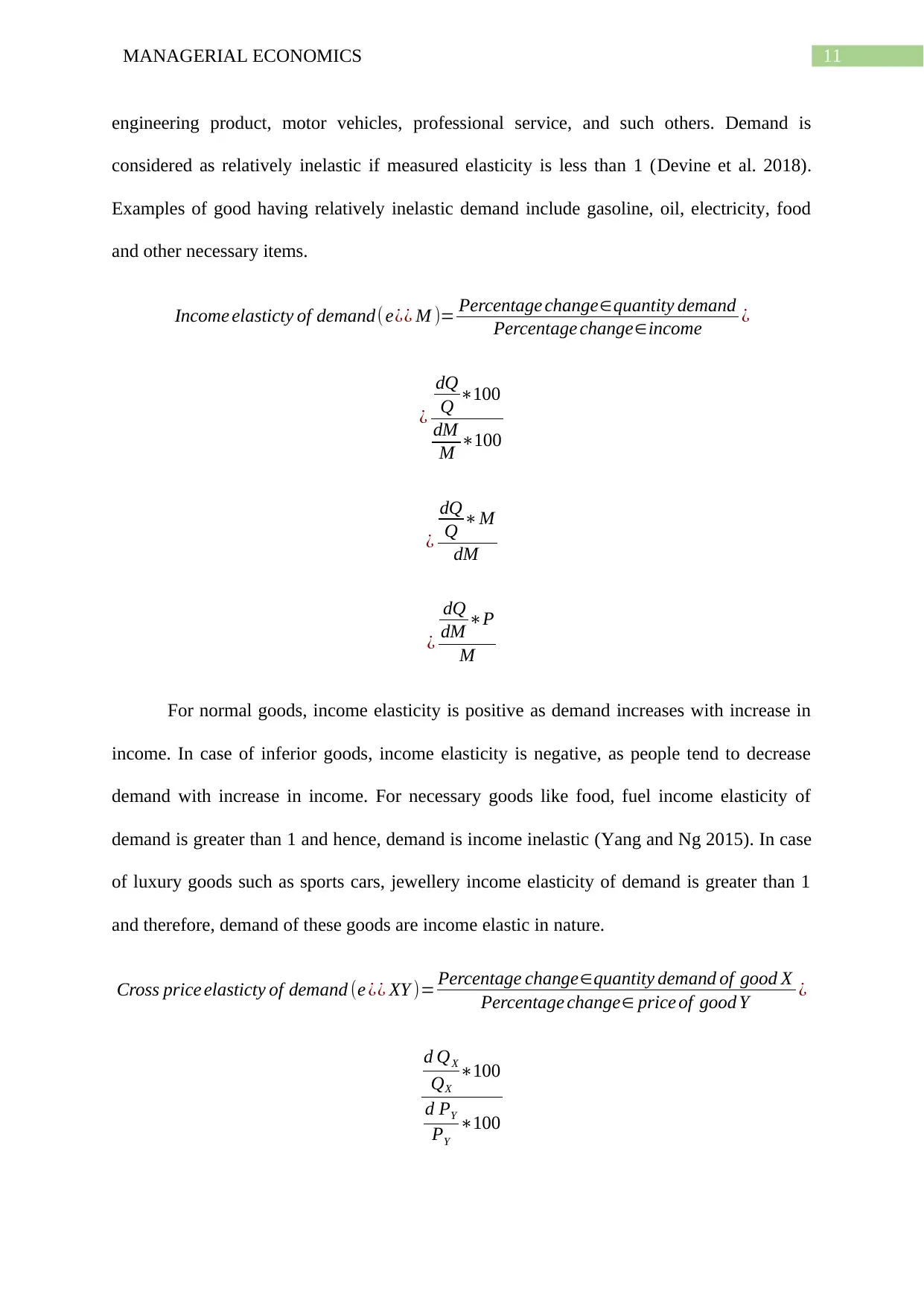
11MANAGERIAL ECONOMICS
engineering product, motor vehicles, professional service, and such others. Demand is
considered as relatively inelastic if measured elasticity is less than 1 (Devine et al. 2018).
Examples of good having relatively inelastic demand include gasoline, oil, electricity, food
and other necessary items.
Income elasticty of demand( e¿¿ M )= Percentage change∈quantity demand
Percentage change∈income ¿
¿
dQ
Q ∗100
dM
M ∗100
¿
dQ
Q ∗M
dM
¿
dQ
dM ∗P
M
For normal goods, income elasticity is positive as demand increases with increase in
income. In case of inferior goods, income elasticity is negative, as people tend to decrease
demand with increase in income. For necessary goods like food, fuel income elasticity of
demand is greater than 1 and hence, demand is income inelastic (Yang and Ng 2015). In case
of luxury goods such as sports cars, jewellery income elasticity of demand is greater than 1
and therefore, demand of these goods are income elastic in nature.
Cross price elasticty of demand (e ¿¿ XY )= Percentage change∈quantity demand of good X
Percentage change∈ price of good Y ¿
d QX
QX
∗100
d PY
PY
∗100
engineering product, motor vehicles, professional service, and such others. Demand is
considered as relatively inelastic if measured elasticity is less than 1 (Devine et al. 2018).
Examples of good having relatively inelastic demand include gasoline, oil, electricity, food
and other necessary items.
Income elasticty of demand( e¿¿ M )= Percentage change∈quantity demand
Percentage change∈income ¿
¿
dQ
Q ∗100
dM
M ∗100
¿
dQ
Q ∗M
dM
¿
dQ
dM ∗P
M
For normal goods, income elasticity is positive as demand increases with increase in
income. In case of inferior goods, income elasticity is negative, as people tend to decrease
demand with increase in income. For necessary goods like food, fuel income elasticity of
demand is greater than 1 and hence, demand is income inelastic (Yang and Ng 2015). In case
of luxury goods such as sports cars, jewellery income elasticity of demand is greater than 1
and therefore, demand of these goods are income elastic in nature.
Cross price elasticty of demand (e ¿¿ XY )= Percentage change∈quantity demand of good X
Percentage change∈ price of good Y ¿
d QX
QX
∗100
d PY
PY
∗100
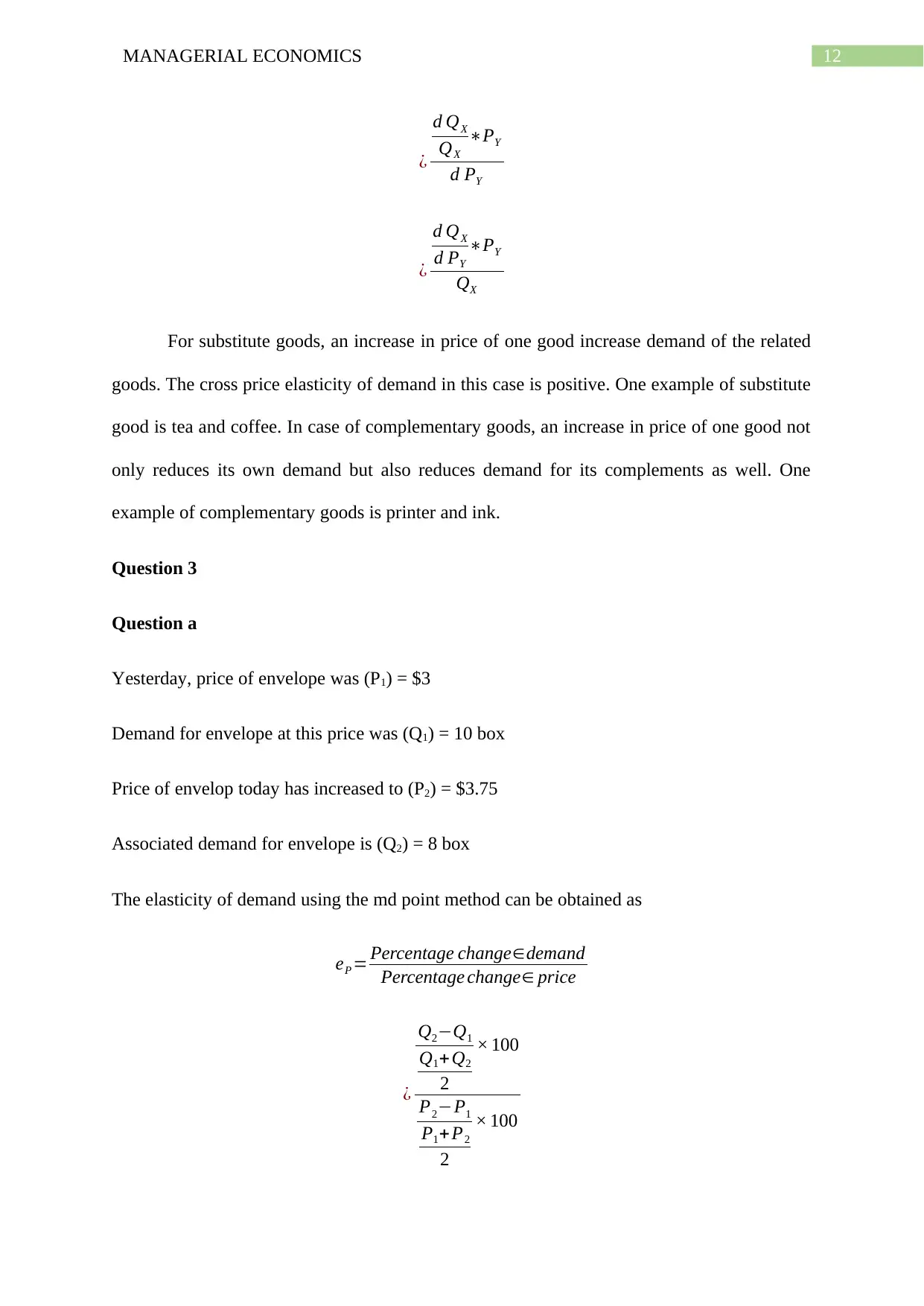
12MANAGERIAL ECONOMICS
¿
d QX
QX
∗PY
d PY
¿
d QX
d PY
∗PY
QX
For substitute goods, an increase in price of one good increase demand of the related
goods. The cross price elasticity of demand in this case is positive. One example of substitute
good is tea and coffee. In case of complementary goods, an increase in price of one good not
only reduces its own demand but also reduces demand for its complements as well. One
example of complementary goods is printer and ink.
Question 3
Question a
Yesterday, price of envelope was (P1) = $3
Demand for envelope at this price was (Q1) = 10 box
Price of envelop today has increased to (P2) = $3.75
Associated demand for envelope is (Q2) = 8 box
The elasticity of demand using the md point method can be obtained as
eP = Percentage change∈demand
Percentage change∈ price
¿
Q2−Q1
Q1+Q2
2
× 100
P2−P1
P1+P2
2
× 100
¿
d QX
QX
∗PY
d PY
¿
d QX
d PY
∗PY
QX
For substitute goods, an increase in price of one good increase demand of the related
goods. The cross price elasticity of demand in this case is positive. One example of substitute
good is tea and coffee. In case of complementary goods, an increase in price of one good not
only reduces its own demand but also reduces demand for its complements as well. One
example of complementary goods is printer and ink.
Question 3
Question a
Yesterday, price of envelope was (P1) = $3
Demand for envelope at this price was (Q1) = 10 box
Price of envelop today has increased to (P2) = $3.75
Associated demand for envelope is (Q2) = 8 box
The elasticity of demand using the md point method can be obtained as
eP = Percentage change∈demand
Percentage change∈ price
¿
Q2−Q1
Q1+Q2
2
× 100
P2−P1
P1+P2
2
× 100
Paraphrase This Document
Need a fresh take? Get an instant paraphrase of this document with our AI Paraphraser
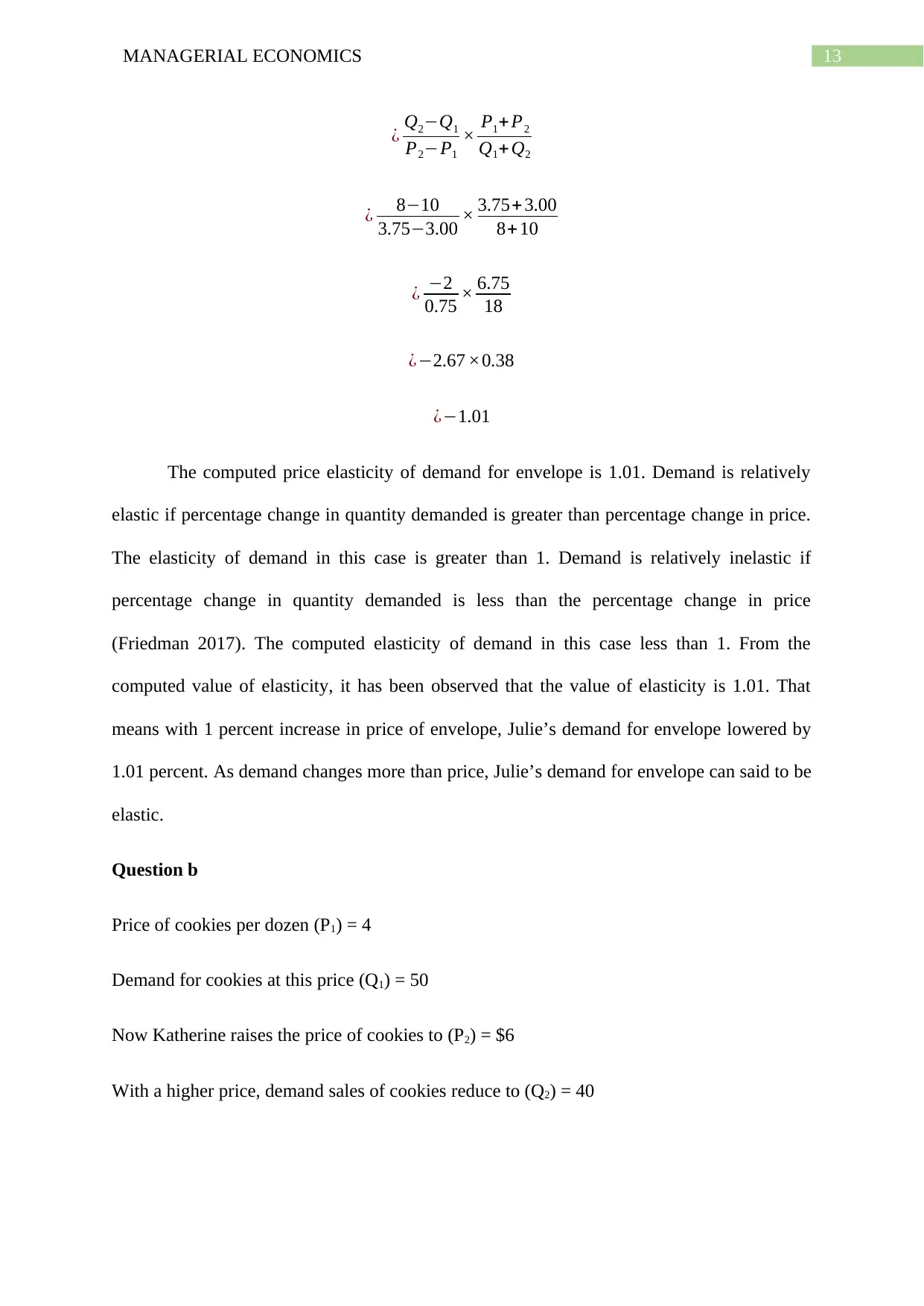
13MANAGERIAL ECONOMICS
¿ Q2−Q1
P2−P1
× P1+ P2
Q1+ Q2
¿ 8−10
3.75−3.00 × 3.75+ 3.00
8+ 10
¿ −2
0.75 × 6.75
18
¿−2.67 ×0.38
¿−1.01
The computed price elasticity of demand for envelope is 1.01. Demand is relatively
elastic if percentage change in quantity demanded is greater than percentage change in price.
The elasticity of demand in this case is greater than 1. Demand is relatively inelastic if
percentage change in quantity demanded is less than the percentage change in price
(Friedman 2017). The computed elasticity of demand in this case less than 1. From the
computed value of elasticity, it has been observed that the value of elasticity is 1.01. That
means with 1 percent increase in price of envelope, Julie’s demand for envelope lowered by
1.01 percent. As demand changes more than price, Julie’s demand for envelope can said to be
elastic.
Question b
Price of cookies per dozen (P1) = 4
Demand for cookies at this price (Q1) = 50
Now Katherine raises the price of cookies to (P2) = $6
With a higher price, demand sales of cookies reduce to (Q2) = 40
¿ Q2−Q1
P2−P1
× P1+ P2
Q1+ Q2
¿ 8−10
3.75−3.00 × 3.75+ 3.00
8+ 10
¿ −2
0.75 × 6.75
18
¿−2.67 ×0.38
¿−1.01
The computed price elasticity of demand for envelope is 1.01. Demand is relatively
elastic if percentage change in quantity demanded is greater than percentage change in price.
The elasticity of demand in this case is greater than 1. Demand is relatively inelastic if
percentage change in quantity demanded is less than the percentage change in price
(Friedman 2017). The computed elasticity of demand in this case less than 1. From the
computed value of elasticity, it has been observed that the value of elasticity is 1.01. That
means with 1 percent increase in price of envelope, Julie’s demand for envelope lowered by
1.01 percent. As demand changes more than price, Julie’s demand for envelope can said to be
elastic.
Question b
Price of cookies per dozen (P1) = 4
Demand for cookies at this price (Q1) = 50
Now Katherine raises the price of cookies to (P2) = $6
With a higher price, demand sales of cookies reduce to (Q2) = 40
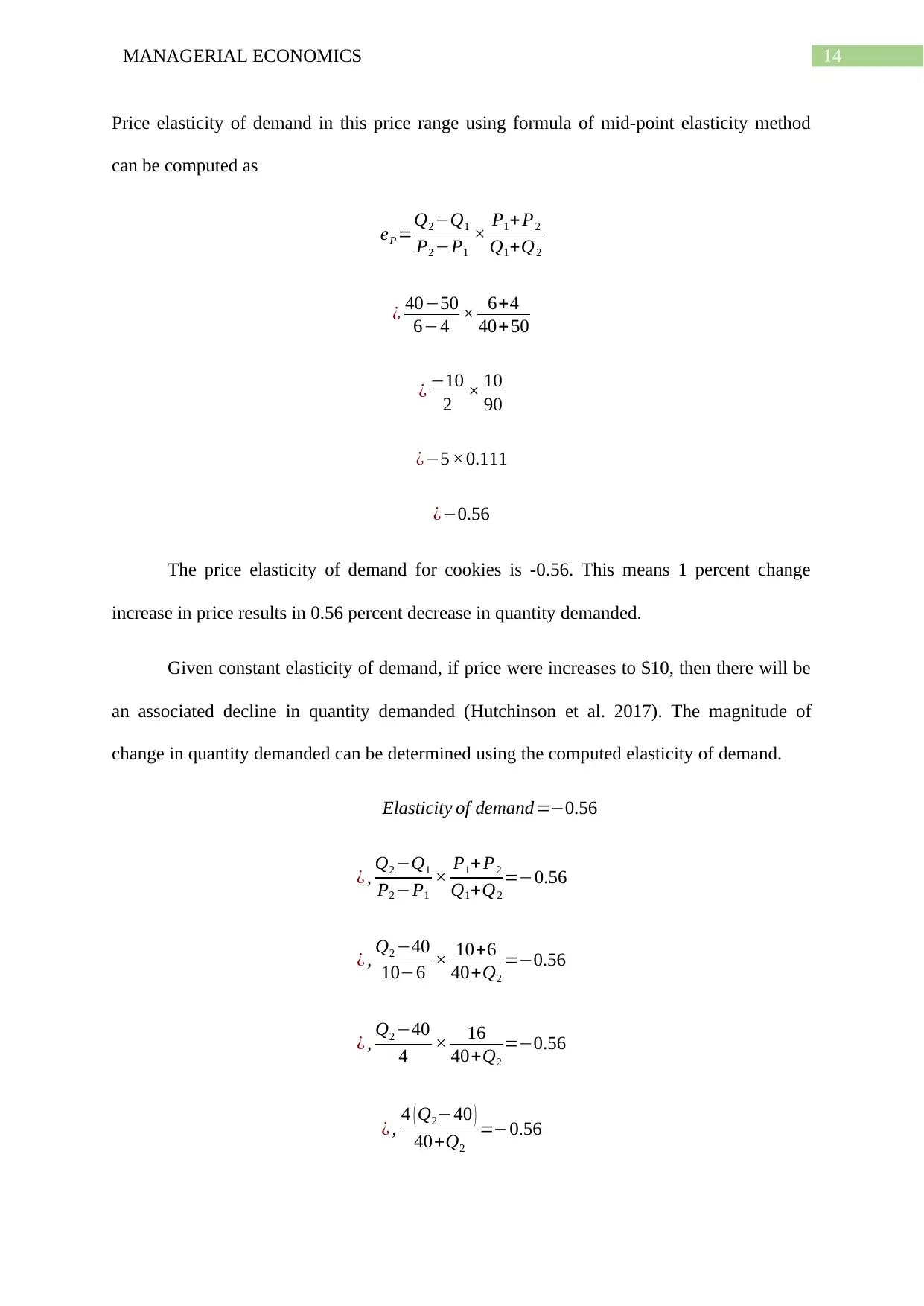
14MANAGERIAL ECONOMICS
Price elasticity of demand in this price range using formula of mid-point elasticity method
can be computed as
eP =Q2 −Q1
P2 −P1
× P1+P2
Q1+Q2
¿ 40−50
6−4 × 6+4
40+50
¿ −10
2 × 10
90
¿−5 ×0.111
¿−0.56
The price elasticity of demand for cookies is -0.56. This means 1 percent change
increase in price results in 0.56 percent decrease in quantity demanded.
Given constant elasticity of demand, if price were increases to $10, then there will be
an associated decline in quantity demanded (Hutchinson et al. 2017). The magnitude of
change in quantity demanded can be determined using the computed elasticity of demand.
Elasticity of demand=−0.56
¿ , Q2 −Q1
P2 −P1
× P1+ P2
Q1+Q2
=−0.56
¿ , Q2 −40
10−6 × 10+6
40+Q2
=−0.56
¿ , Q2 −40
4 × 16
40+Q2
=−0.56
¿ , 4 ( Q2−40 )
40+Q2
=−0.56
Price elasticity of demand in this price range using formula of mid-point elasticity method
can be computed as
eP =Q2 −Q1
P2 −P1
× P1+P2
Q1+Q2
¿ 40−50
6−4 × 6+4
40+50
¿ −10
2 × 10
90
¿−5 ×0.111
¿−0.56
The price elasticity of demand for cookies is -0.56. This means 1 percent change
increase in price results in 0.56 percent decrease in quantity demanded.
Given constant elasticity of demand, if price were increases to $10, then there will be
an associated decline in quantity demanded (Hutchinson et al. 2017). The magnitude of
change in quantity demanded can be determined using the computed elasticity of demand.
Elasticity of demand=−0.56
¿ , Q2 −Q1
P2 −P1
× P1+ P2
Q1+Q2
=−0.56
¿ , Q2 −40
10−6 × 10+6
40+Q2
=−0.56
¿ , Q2 −40
4 × 16
40+Q2
=−0.56
¿ , 4 ( Q2−40 )
40+Q2
=−0.56
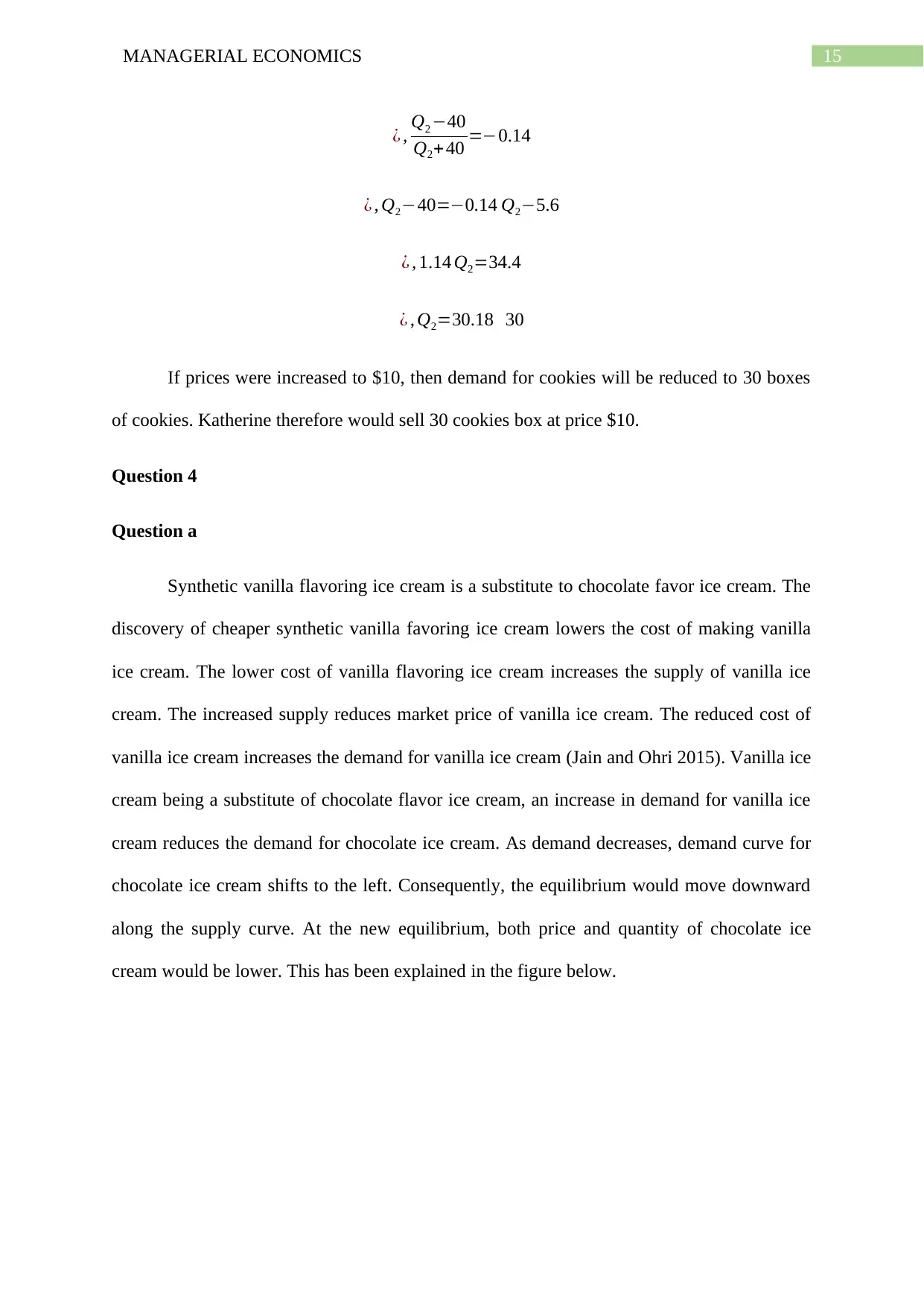
15MANAGERIAL ECONOMICS
¿ , Q2 −40
Q2+40 =−0.14
¿ , Q2−40=−0.14 Q2−5.6
¿ , 1.14 Q2=34.4
¿ , Q2=30.18 30
If prices were increased to $10, then demand for cookies will be reduced to 30 boxes
of cookies. Katherine therefore would sell 30 cookies box at price $10.
Question 4
Question a
Synthetic vanilla flavoring ice cream is a substitute to chocolate favor ice cream. The
discovery of cheaper synthetic vanilla favoring ice cream lowers the cost of making vanilla
ice cream. The lower cost of vanilla flavoring ice cream increases the supply of vanilla ice
cream. The increased supply reduces market price of vanilla ice cream. The reduced cost of
vanilla ice cream increases the demand for vanilla ice cream (Jain and Ohri 2015). Vanilla ice
cream being a substitute of chocolate flavor ice cream, an increase in demand for vanilla ice
cream reduces the demand for chocolate ice cream. As demand decreases, demand curve for
chocolate ice cream shifts to the left. Consequently, the equilibrium would move downward
along the supply curve. At the new equilibrium, both price and quantity of chocolate ice
cream would be lower. This has been explained in the figure below.
¿ , Q2 −40
Q2+40 =−0.14
¿ , Q2−40=−0.14 Q2−5.6
¿ , 1.14 Q2=34.4
¿ , Q2=30.18 30
If prices were increased to $10, then demand for cookies will be reduced to 30 boxes
of cookies. Katherine therefore would sell 30 cookies box at price $10.
Question 4
Question a
Synthetic vanilla flavoring ice cream is a substitute to chocolate favor ice cream. The
discovery of cheaper synthetic vanilla favoring ice cream lowers the cost of making vanilla
ice cream. The lower cost of vanilla flavoring ice cream increases the supply of vanilla ice
cream. The increased supply reduces market price of vanilla ice cream. The reduced cost of
vanilla ice cream increases the demand for vanilla ice cream (Jain and Ohri 2015). Vanilla ice
cream being a substitute of chocolate flavor ice cream, an increase in demand for vanilla ice
cream reduces the demand for chocolate ice cream. As demand decreases, demand curve for
chocolate ice cream shifts to the left. Consequently, the equilibrium would move downward
along the supply curve. At the new equilibrium, both price and quantity of chocolate ice
cream would be lower. This has been explained in the figure below.
Secure Best Marks with AI Grader
Need help grading? Try our AI Grader for instant feedback on your assignments.
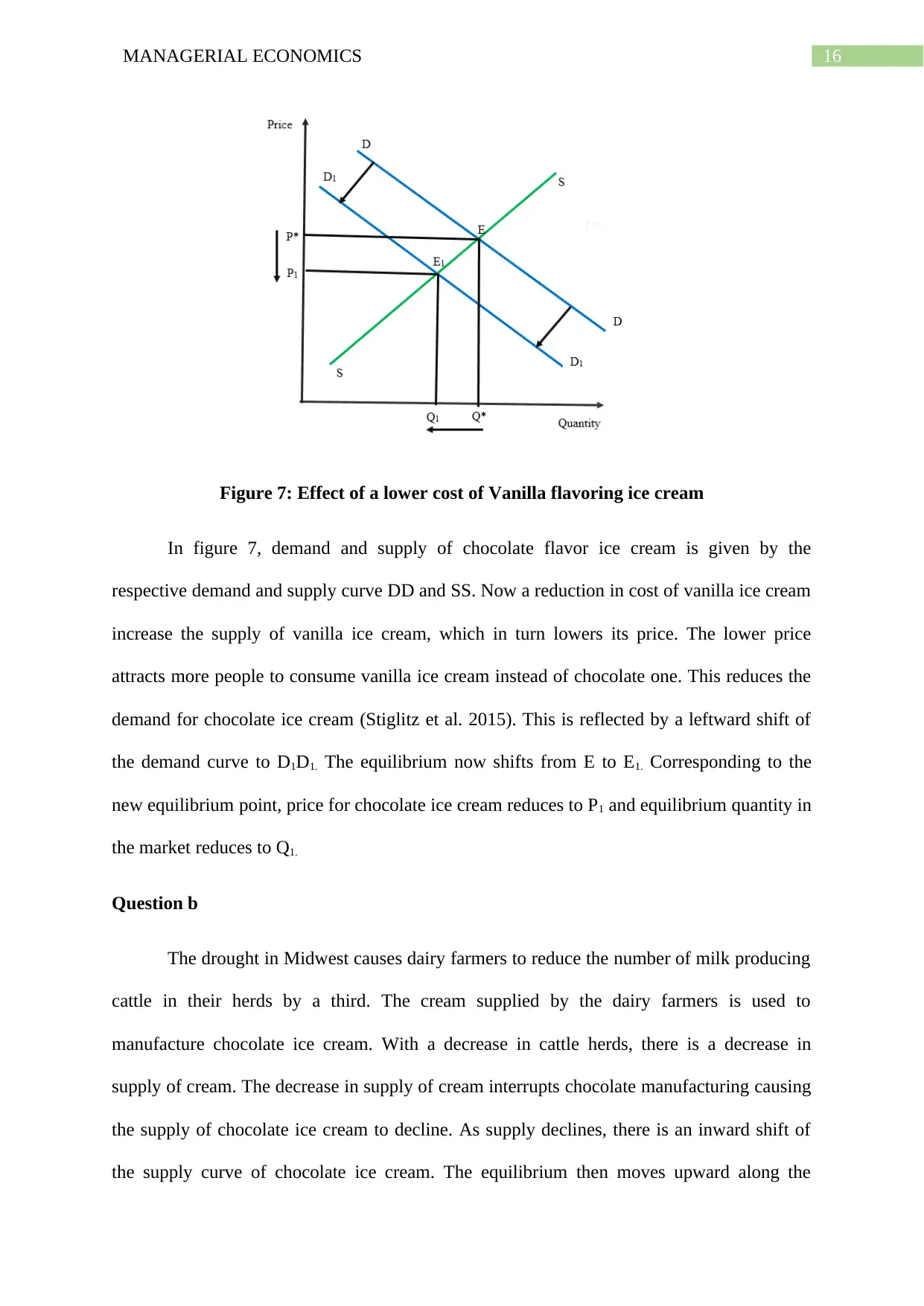
16MANAGERIAL ECONOMICS
Figure 7: Effect of a lower cost of Vanilla flavoring ice cream
In figure 7, demand and supply of chocolate flavor ice cream is given by the
respective demand and supply curve DD and SS. Now a reduction in cost of vanilla ice cream
increase the supply of vanilla ice cream, which in turn lowers its price. The lower price
attracts more people to consume vanilla ice cream instead of chocolate one. This reduces the
demand for chocolate ice cream (Stiglitz et al. 2015). This is reflected by a leftward shift of
the demand curve to D1D1. The equilibrium now shifts from E to E1. Corresponding to the
new equilibrium point, price for chocolate ice cream reduces to P1 and equilibrium quantity in
the market reduces to Q1.
Question b
The drought in Midwest causes dairy farmers to reduce the number of milk producing
cattle in their herds by a third. The cream supplied by the dairy farmers is used to
manufacture chocolate ice cream. With a decrease in cattle herds, there is a decrease in
supply of cream. The decrease in supply of cream interrupts chocolate manufacturing causing
the supply of chocolate ice cream to decline. As supply declines, there is an inward shift of
the supply curve of chocolate ice cream. The equilibrium then moves upward along the
Figure 7: Effect of a lower cost of Vanilla flavoring ice cream
In figure 7, demand and supply of chocolate flavor ice cream is given by the
respective demand and supply curve DD and SS. Now a reduction in cost of vanilla ice cream
increase the supply of vanilla ice cream, which in turn lowers its price. The lower price
attracts more people to consume vanilla ice cream instead of chocolate one. This reduces the
demand for chocolate ice cream (Stiglitz et al. 2015). This is reflected by a leftward shift of
the demand curve to D1D1. The equilibrium now shifts from E to E1. Corresponding to the
new equilibrium point, price for chocolate ice cream reduces to P1 and equilibrium quantity in
the market reduces to Q1.
Question b
The drought in Midwest causes dairy farmers to reduce the number of milk producing
cattle in their herds by a third. The cream supplied by the dairy farmers is used to
manufacture chocolate ice cream. With a decrease in cattle herds, there is a decrease in
supply of cream. The decrease in supply of cream interrupts chocolate manufacturing causing
the supply of chocolate ice cream to decline. As supply declines, there is an inward shift of
the supply curve of chocolate ice cream. The equilibrium then moves upward along the
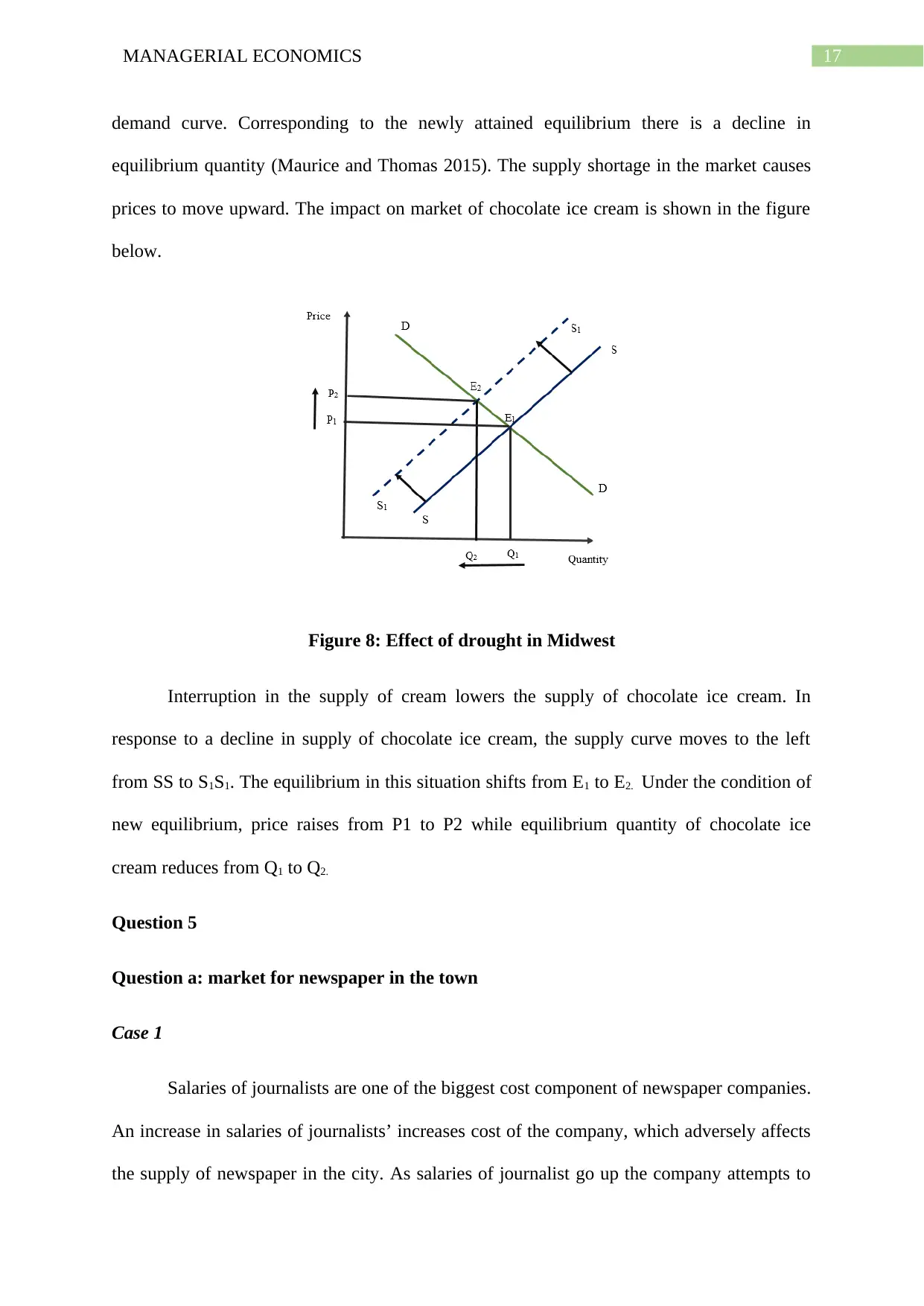
17MANAGERIAL ECONOMICS
demand curve. Corresponding to the newly attained equilibrium there is a decline in
equilibrium quantity (Maurice and Thomas 2015). The supply shortage in the market causes
prices to move upward. The impact on market of chocolate ice cream is shown in the figure
below.
Figure 8: Effect of drought in Midwest
Interruption in the supply of cream lowers the supply of chocolate ice cream. In
response to a decline in supply of chocolate ice cream, the supply curve moves to the left
from SS to S1S1. The equilibrium in this situation shifts from E1 to E2. Under the condition of
new equilibrium, price raises from P1 to P2 while equilibrium quantity of chocolate ice
cream reduces from Q1 to Q2.
Question 5
Question a: market for newspaper in the town
Case 1
Salaries of journalists are one of the biggest cost component of newspaper companies.
An increase in salaries of journalists’ increases cost of the company, which adversely affects
the supply of newspaper in the city. As salaries of journalist go up the company attempts to
demand curve. Corresponding to the newly attained equilibrium there is a decline in
equilibrium quantity (Maurice and Thomas 2015). The supply shortage in the market causes
prices to move upward. The impact on market of chocolate ice cream is shown in the figure
below.
Figure 8: Effect of drought in Midwest
Interruption in the supply of cream lowers the supply of chocolate ice cream. In
response to a decline in supply of chocolate ice cream, the supply curve moves to the left
from SS to S1S1. The equilibrium in this situation shifts from E1 to E2. Under the condition of
new equilibrium, price raises from P1 to P2 while equilibrium quantity of chocolate ice
cream reduces from Q1 to Q2.
Question 5
Question a: market for newspaper in the town
Case 1
Salaries of journalists are one of the biggest cost component of newspaper companies.
An increase in salaries of journalists’ increases cost of the company, which adversely affects
the supply of newspaper in the city. As salaries of journalist go up the company attempts to
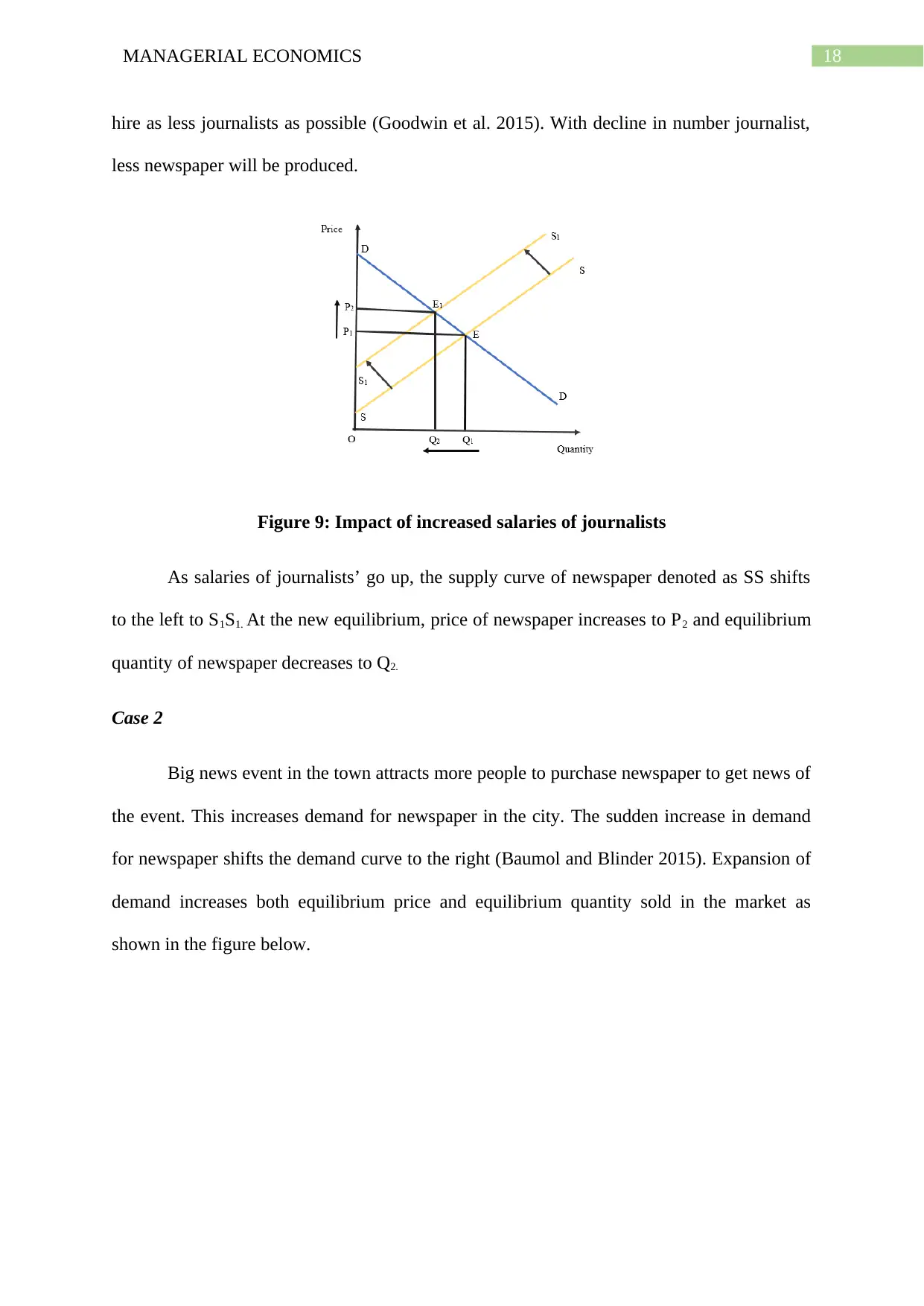
18MANAGERIAL ECONOMICS
hire as less journalists as possible (Goodwin et al. 2015). With decline in number journalist,
less newspaper will be produced.
Figure 9: Impact of increased salaries of journalists
As salaries of journalists’ go up, the supply curve of newspaper denoted as SS shifts
to the left to S1S1. At the new equilibrium, price of newspaper increases to P2 and equilibrium
quantity of newspaper decreases to Q2.
Case 2
Big news event in the town attracts more people to purchase newspaper to get news of
the event. This increases demand for newspaper in the city. The sudden increase in demand
for newspaper shifts the demand curve to the right (Baumol and Blinder 2015). Expansion of
demand increases both equilibrium price and equilibrium quantity sold in the market as
shown in the figure below.
hire as less journalists as possible (Goodwin et al. 2015). With decline in number journalist,
less newspaper will be produced.
Figure 9: Impact of increased salaries of journalists
As salaries of journalists’ go up, the supply curve of newspaper denoted as SS shifts
to the left to S1S1. At the new equilibrium, price of newspaper increases to P2 and equilibrium
quantity of newspaper decreases to Q2.
Case 2
Big news event in the town attracts more people to purchase newspaper to get news of
the event. This increases demand for newspaper in the city. The sudden increase in demand
for newspaper shifts the demand curve to the right (Baumol and Blinder 2015). Expansion of
demand increases both equilibrium price and equilibrium quantity sold in the market as
shown in the figure below.
Paraphrase This Document
Need a fresh take? Get an instant paraphrase of this document with our AI Paraphraser
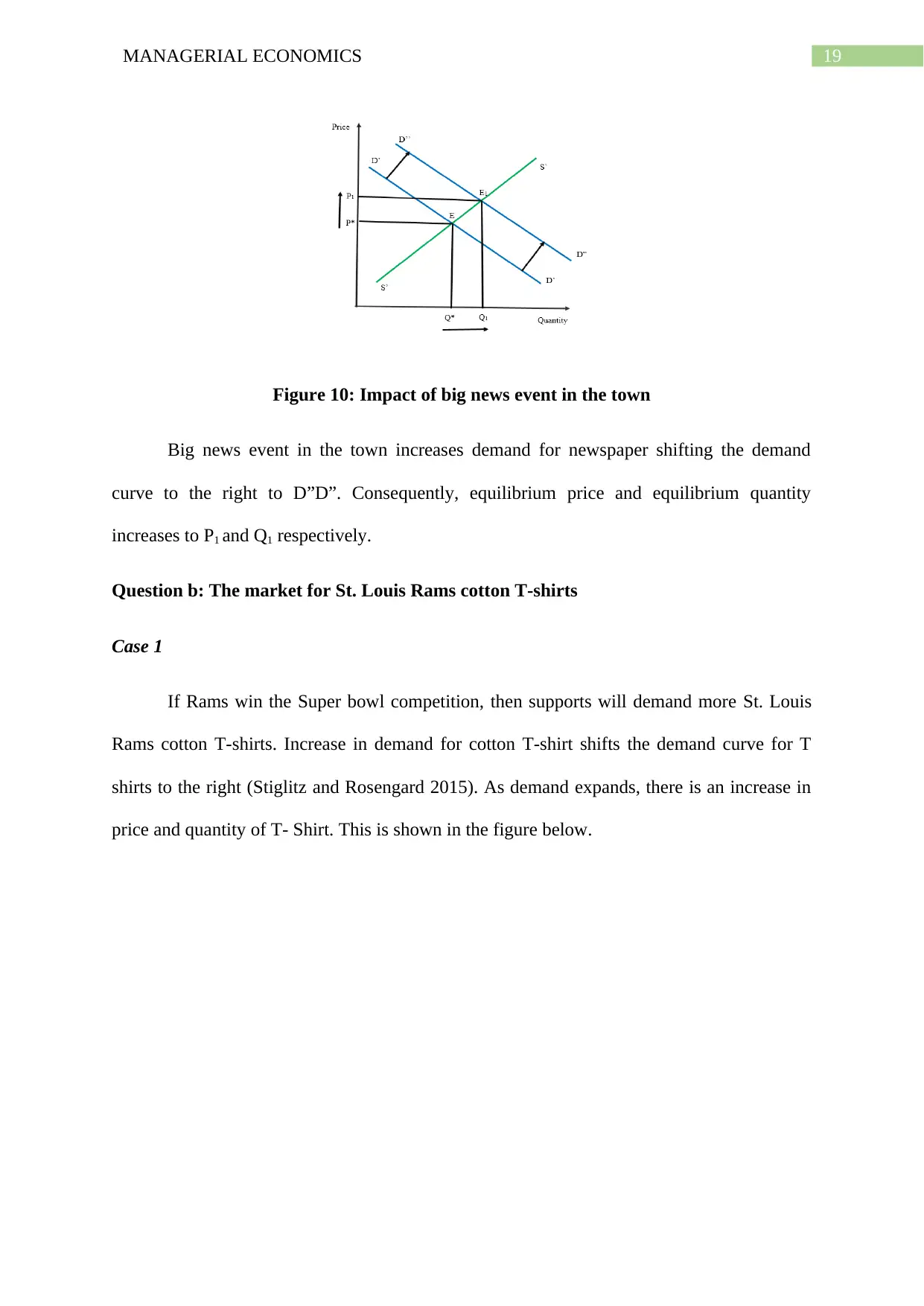
19MANAGERIAL ECONOMICS
Figure 10: Impact of big news event in the town
Big news event in the town increases demand for newspaper shifting the demand
curve to the right to D”D”. Consequently, equilibrium price and equilibrium quantity
increases to P1 and Q1 respectively.
Question b: The market for St. Louis Rams cotton T-shirts
Case 1
If Rams win the Super bowl competition, then supports will demand more St. Louis
Rams cotton T-shirts. Increase in demand for cotton T-shirt shifts the demand curve for T
shirts to the right (Stiglitz and Rosengard 2015). As demand expands, there is an increase in
price and quantity of T- Shirt. This is shown in the figure below.
Figure 10: Impact of big news event in the town
Big news event in the town increases demand for newspaper shifting the demand
curve to the right to D”D”. Consequently, equilibrium price and equilibrium quantity
increases to P1 and Q1 respectively.
Question b: The market for St. Louis Rams cotton T-shirts
Case 1
If Rams win the Super bowl competition, then supports will demand more St. Louis
Rams cotton T-shirts. Increase in demand for cotton T-shirt shifts the demand curve for T
shirts to the right (Stiglitz and Rosengard 2015). As demand expands, there is an increase in
price and quantity of T- Shirt. This is shown in the figure below.
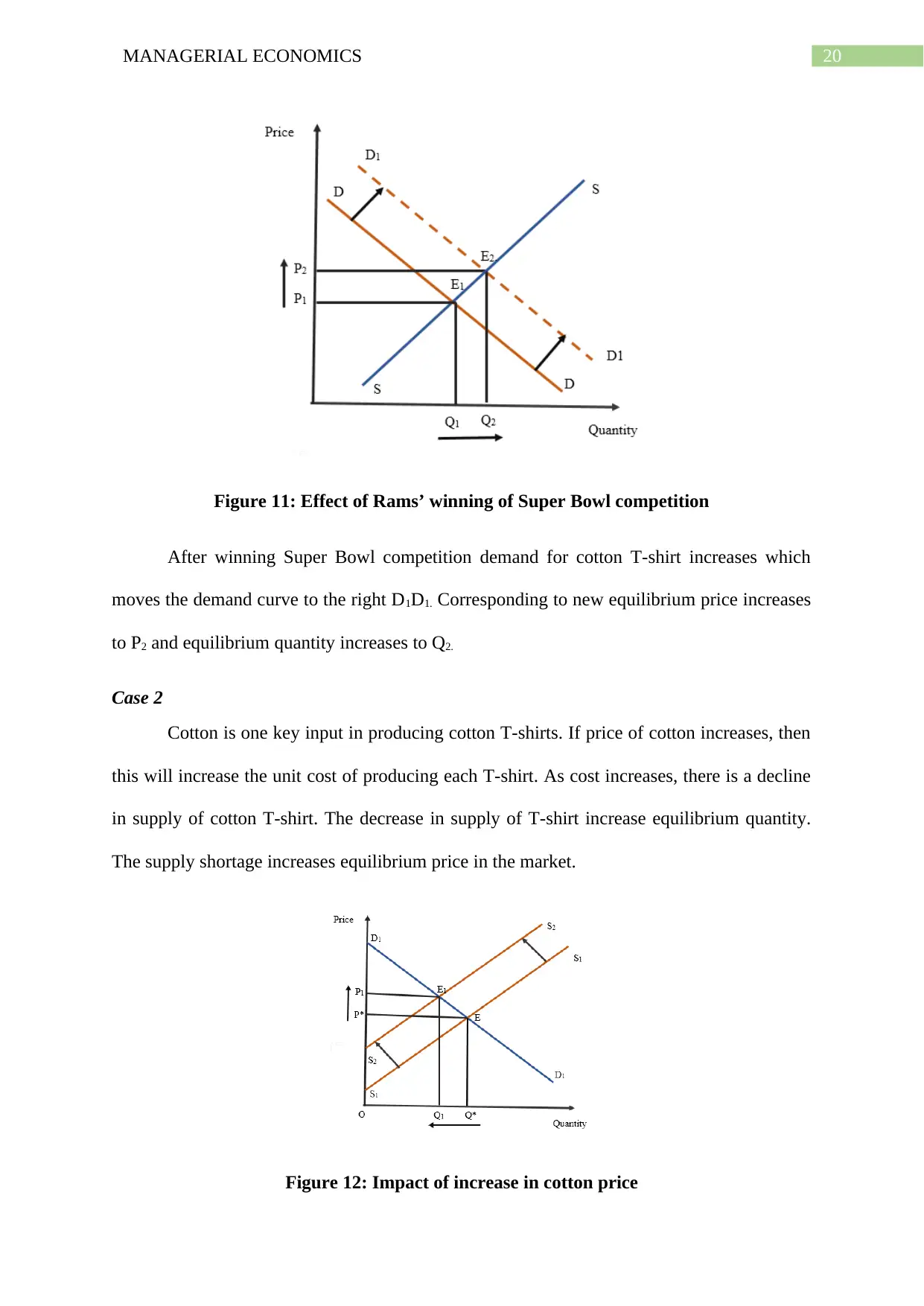
20MANAGERIAL ECONOMICS
Figure 11: Effect of Rams’ winning of Super Bowl competition
After winning Super Bowl competition demand for cotton T-shirt increases which
moves the demand curve to the right D1D1. Corresponding to new equilibrium price increases
to P2 and equilibrium quantity increases to Q2.
Case 2
Cotton is one key input in producing cotton T-shirts. If price of cotton increases, then
this will increase the unit cost of producing each T-shirt. As cost increases, there is a decline
in supply of cotton T-shirt. The decrease in supply of T-shirt increase equilibrium quantity.
The supply shortage increases equilibrium price in the market.
Figure 12: Impact of increase in cotton price
Figure 11: Effect of Rams’ winning of Super Bowl competition
After winning Super Bowl competition demand for cotton T-shirt increases which
moves the demand curve to the right D1D1. Corresponding to new equilibrium price increases
to P2 and equilibrium quantity increases to Q2.
Case 2
Cotton is one key input in producing cotton T-shirts. If price of cotton increases, then
this will increase the unit cost of producing each T-shirt. As cost increases, there is a decline
in supply of cotton T-shirt. The decrease in supply of T-shirt increase equilibrium quantity.
The supply shortage increases equilibrium price in the market.
Figure 12: Impact of increase in cotton price
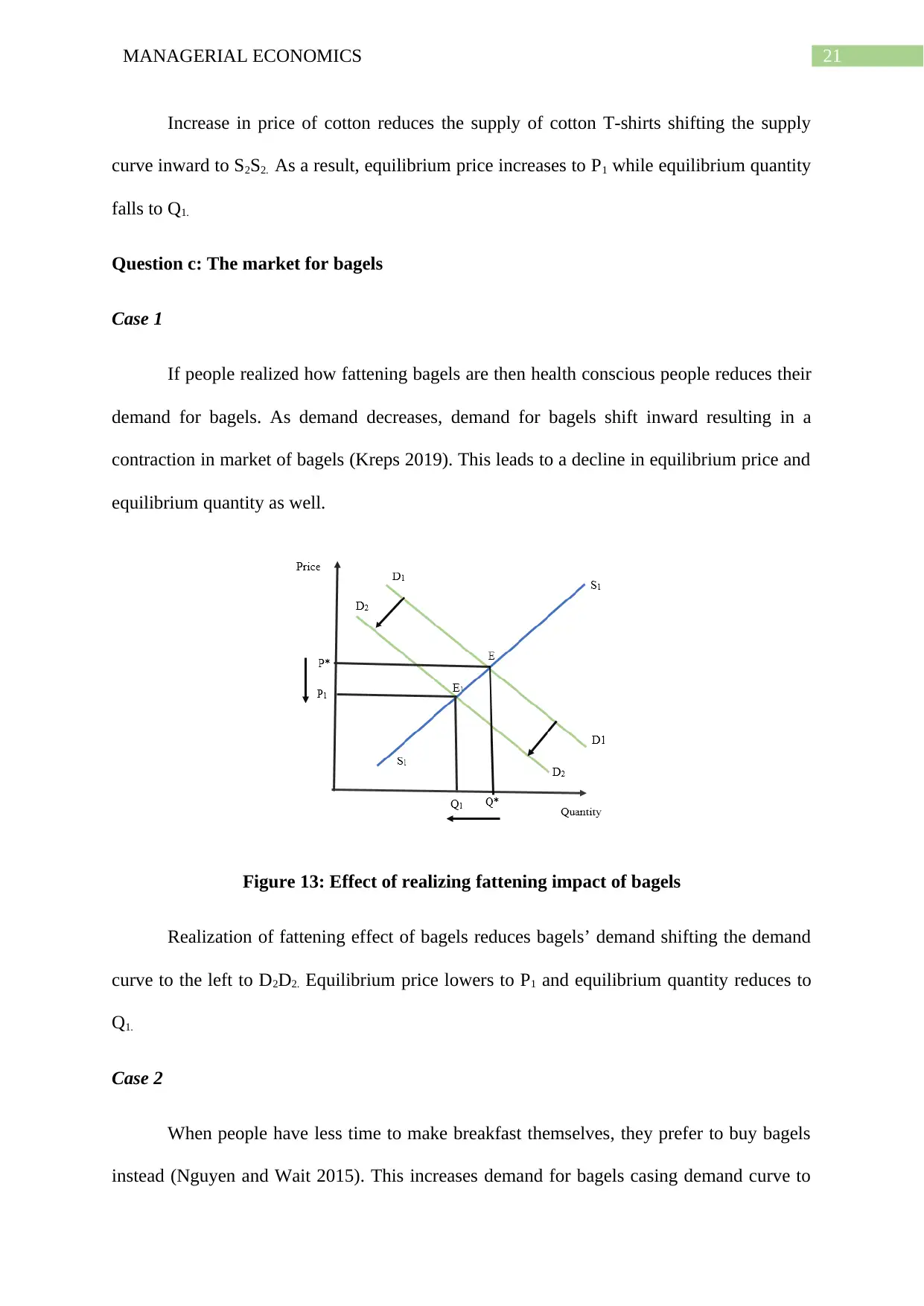
21MANAGERIAL ECONOMICS
Increase in price of cotton reduces the supply of cotton T-shirts shifting the supply
curve inward to S2S2. As a result, equilibrium price increases to P1 while equilibrium quantity
falls to Q1.
Question c: The market for bagels
Case 1
If people realized how fattening bagels are then health conscious people reduces their
demand for bagels. As demand decreases, demand for bagels shift inward resulting in a
contraction in market of bagels (Kreps 2019). This leads to a decline in equilibrium price and
equilibrium quantity as well.
Figure 13: Effect of realizing fattening impact of bagels
Realization of fattening effect of bagels reduces bagels’ demand shifting the demand
curve to the left to D2D2. Equilibrium price lowers to P1 and equilibrium quantity reduces to
Q1.
Case 2
When people have less time to make breakfast themselves, they prefer to buy bagels
instead (Nguyen and Wait 2015). This increases demand for bagels casing demand curve to
Increase in price of cotton reduces the supply of cotton T-shirts shifting the supply
curve inward to S2S2. As a result, equilibrium price increases to P1 while equilibrium quantity
falls to Q1.
Question c: The market for bagels
Case 1
If people realized how fattening bagels are then health conscious people reduces their
demand for bagels. As demand decreases, demand for bagels shift inward resulting in a
contraction in market of bagels (Kreps 2019). This leads to a decline in equilibrium price and
equilibrium quantity as well.
Figure 13: Effect of realizing fattening impact of bagels
Realization of fattening effect of bagels reduces bagels’ demand shifting the demand
curve to the left to D2D2. Equilibrium price lowers to P1 and equilibrium quantity reduces to
Q1.
Case 2
When people have less time to make breakfast themselves, they prefer to buy bagels
instead (Nguyen and Wait 2015). This increases demand for bagels casing demand curve to
Secure Best Marks with AI Grader
Need help grading? Try our AI Grader for instant feedback on your assignments.
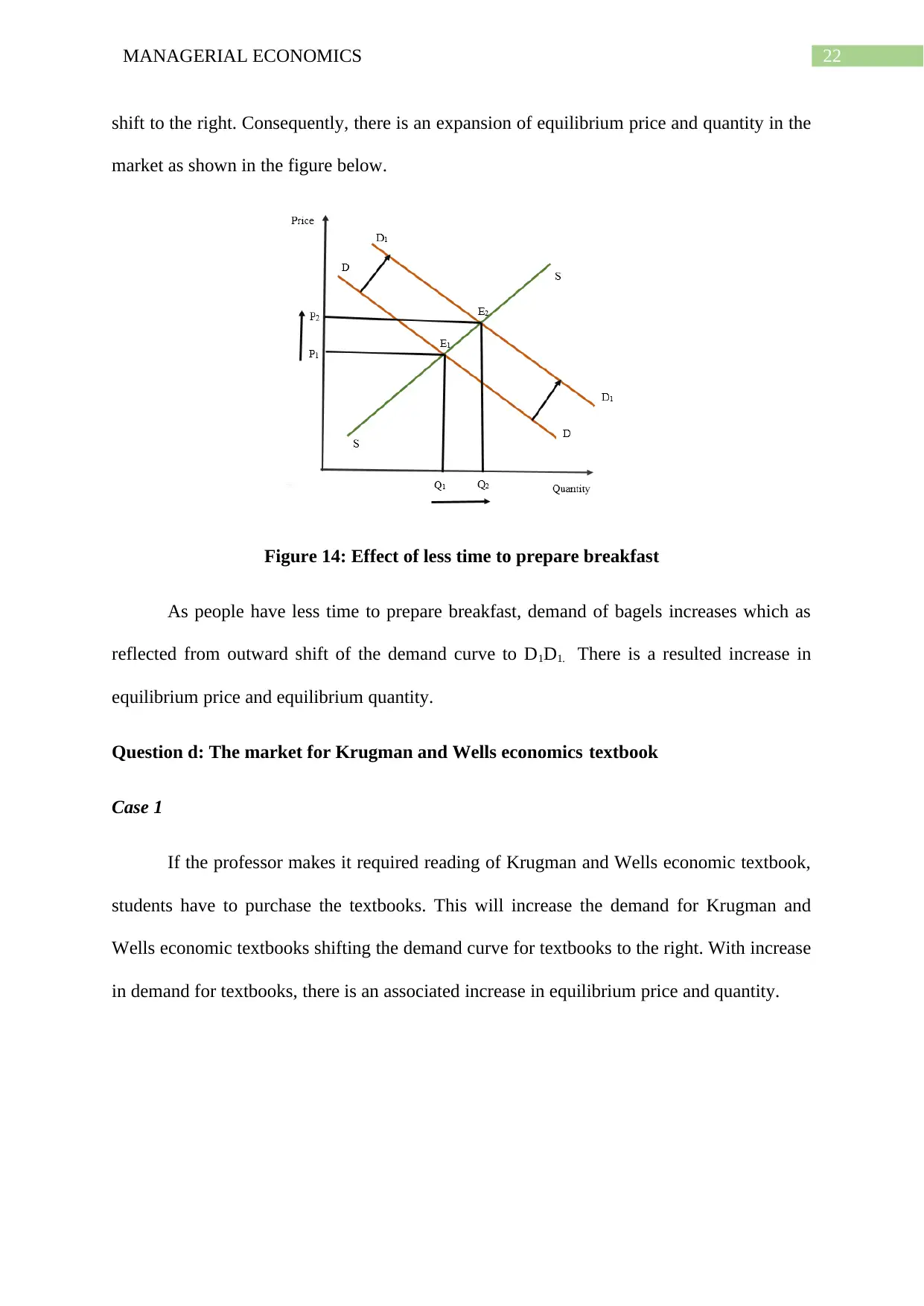
22MANAGERIAL ECONOMICS
shift to the right. Consequently, there is an expansion of equilibrium price and quantity in the
market as shown in the figure below.
Figure 14: Effect of less time to prepare breakfast
As people have less time to prepare breakfast, demand of bagels increases which as
reflected from outward shift of the demand curve to D1D1. There is a resulted increase in
equilibrium price and equilibrium quantity.
Question d: The market for Krugman and Wells economics textbook
Case 1
If the professor makes it required reading of Krugman and Wells economic textbook,
students have to purchase the textbooks. This will increase the demand for Krugman and
Wells economic textbooks shifting the demand curve for textbooks to the right. With increase
in demand for textbooks, there is an associated increase in equilibrium price and quantity.
shift to the right. Consequently, there is an expansion of equilibrium price and quantity in the
market as shown in the figure below.
Figure 14: Effect of less time to prepare breakfast
As people have less time to prepare breakfast, demand of bagels increases which as
reflected from outward shift of the demand curve to D1D1. There is a resulted increase in
equilibrium price and equilibrium quantity.
Question d: The market for Krugman and Wells economics textbook
Case 1
If the professor makes it required reading of Krugman and Wells economic textbook,
students have to purchase the textbooks. This will increase the demand for Krugman and
Wells economic textbooks shifting the demand curve for textbooks to the right. With increase
in demand for textbooks, there is an associated increase in equilibrium price and quantity.
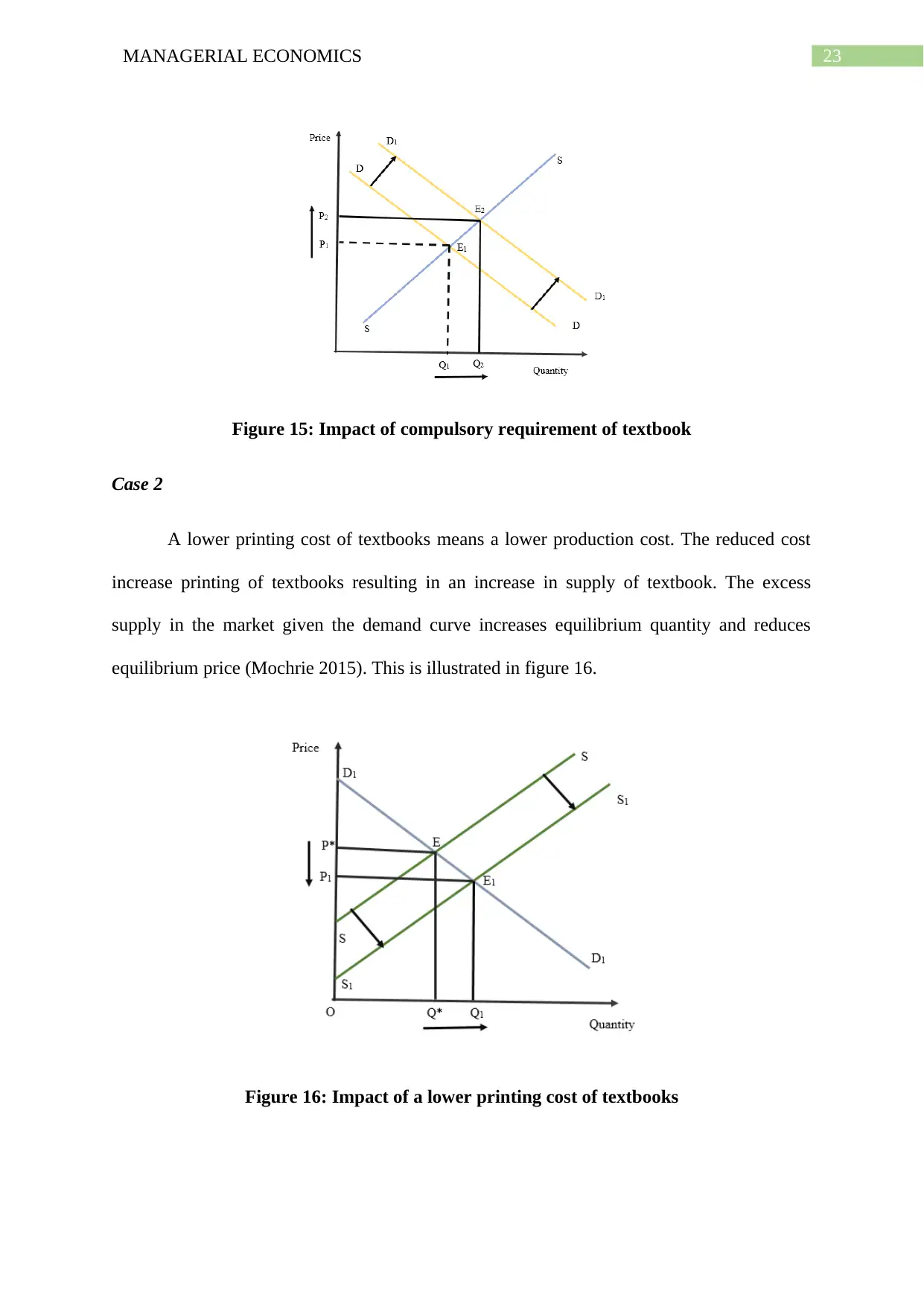
23MANAGERIAL ECONOMICS
Figure 15: Impact of compulsory requirement of textbook
Case 2
A lower printing cost of textbooks means a lower production cost. The reduced cost
increase printing of textbooks resulting in an increase in supply of textbook. The excess
supply in the market given the demand curve increases equilibrium quantity and reduces
equilibrium price (Mochrie 2015). This is illustrated in figure 16.
Figure 16: Impact of a lower printing cost of textbooks
Figure 15: Impact of compulsory requirement of textbook
Case 2
A lower printing cost of textbooks means a lower production cost. The reduced cost
increase printing of textbooks resulting in an increase in supply of textbook. The excess
supply in the market given the demand curve increases equilibrium quantity and reduces
equilibrium price (Mochrie 2015). This is illustrated in figure 16.
Figure 16: Impact of a lower printing cost of textbooks
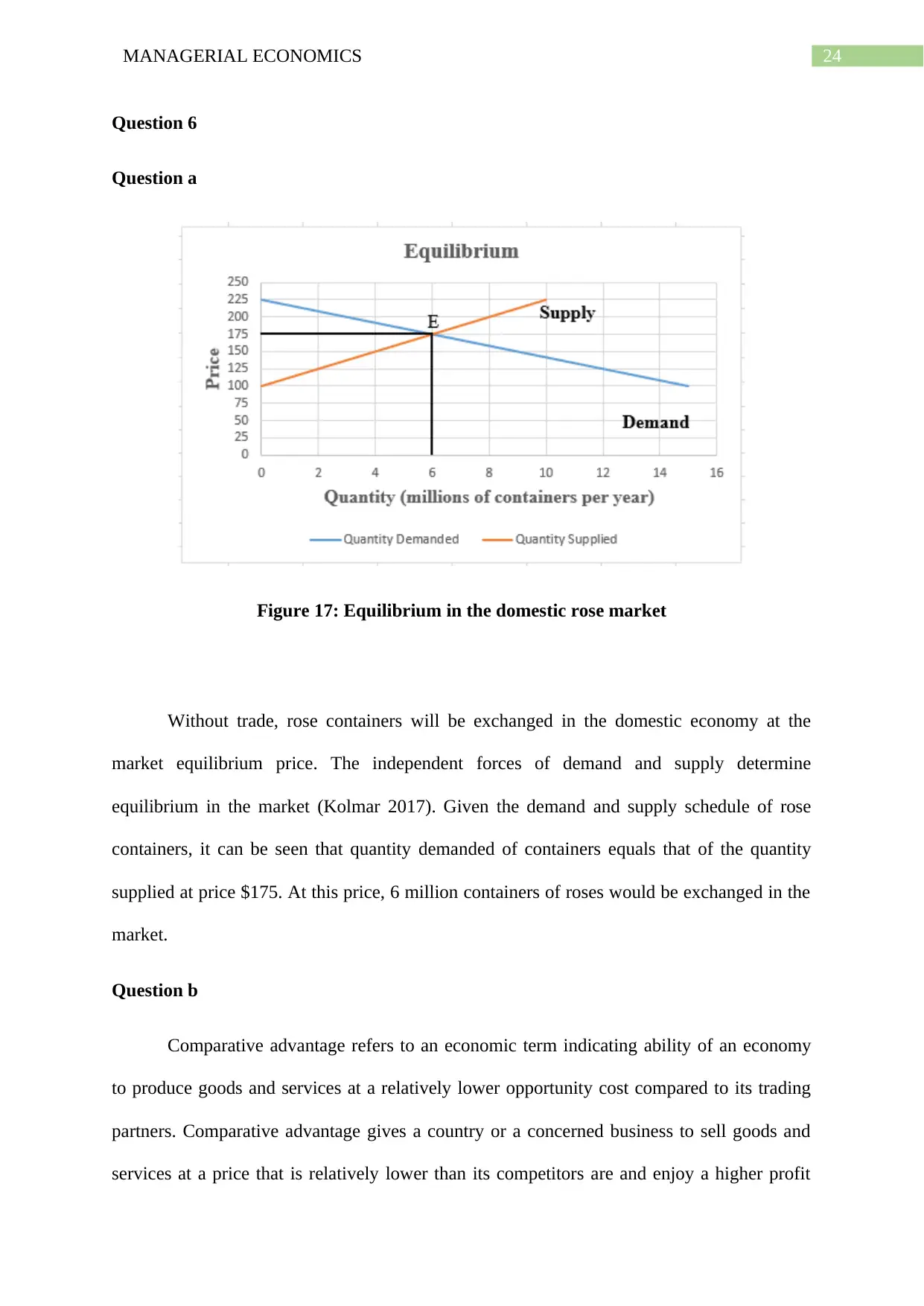
24MANAGERIAL ECONOMICS
Question 6
Question a
Figure 17: Equilibrium in the domestic rose market
Without trade, rose containers will be exchanged in the domestic economy at the
market equilibrium price. The independent forces of demand and supply determine
equilibrium in the market (Kolmar 2017). Given the demand and supply schedule of rose
containers, it can be seen that quantity demanded of containers equals that of the quantity
supplied at price $175. At this price, 6 million containers of roses would be exchanged in the
market.
Question b
Comparative advantage refers to an economic term indicating ability of an economy
to produce goods and services at a relatively lower opportunity cost compared to its trading
partners. Comparative advantage gives a country or a concerned business to sell goods and
services at a price that is relatively lower than its competitors are and enjoy a higher profit
Question 6
Question a
Figure 17: Equilibrium in the domestic rose market
Without trade, rose containers will be exchanged in the domestic economy at the
market equilibrium price. The independent forces of demand and supply determine
equilibrium in the market (Kolmar 2017). Given the demand and supply schedule of rose
containers, it can be seen that quantity demanded of containers equals that of the quantity
supplied at price $175. At this price, 6 million containers of roses would be exchanged in the
market.
Question b
Comparative advantage refers to an economic term indicating ability of an economy
to produce goods and services at a relatively lower opportunity cost compared to its trading
partners. Comparative advantage gives a country or a concerned business to sell goods and
services at a price that is relatively lower than its competitors are and enjoy a higher profit
Paraphrase This Document
Need a fresh take? Get an instant paraphrase of this document with our AI Paraphraser
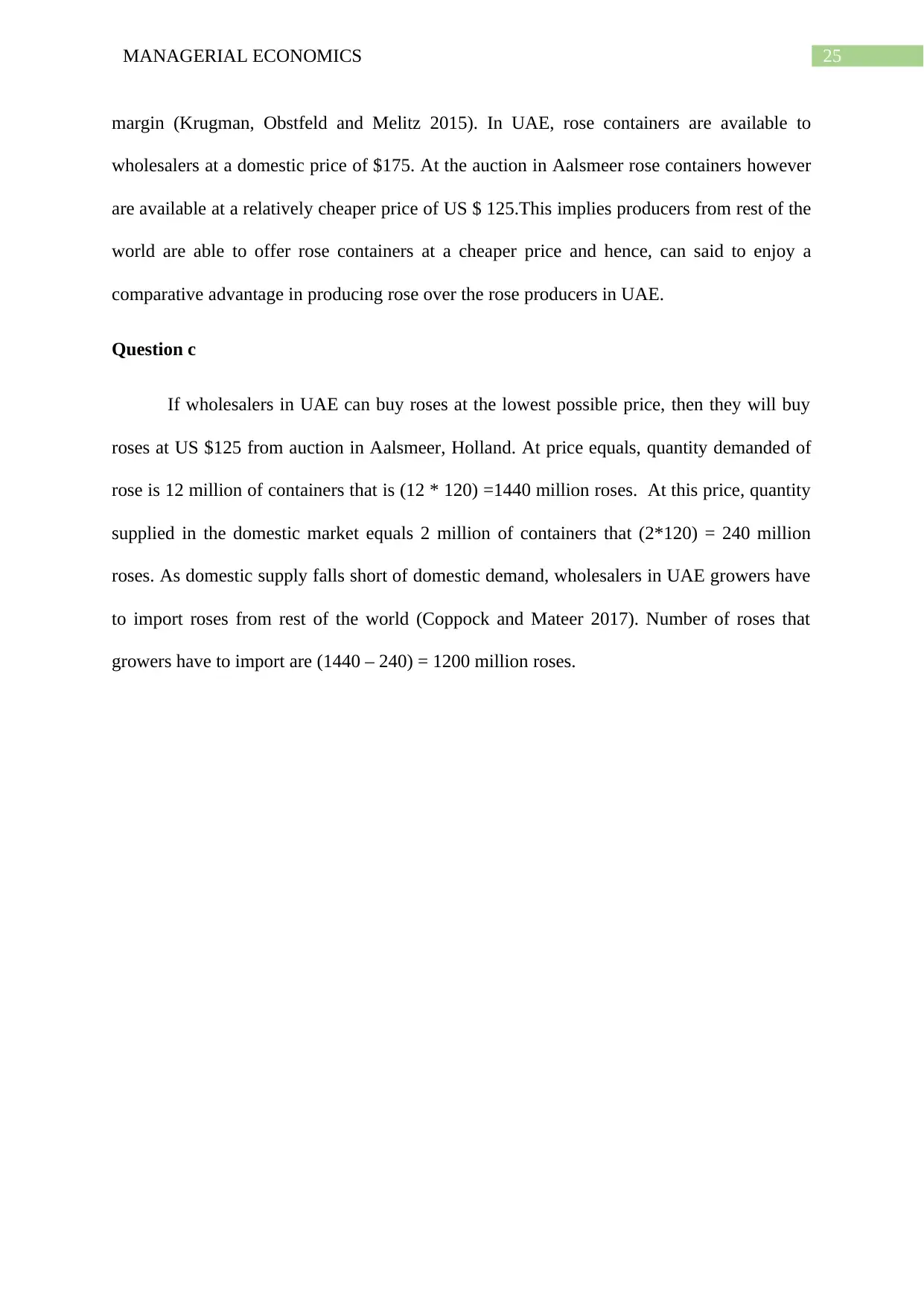
25MANAGERIAL ECONOMICS
margin (Krugman, Obstfeld and Melitz 2015). In UAE, rose containers are available to
wholesalers at a domestic price of $175. At the auction in Aalsmeer rose containers however
are available at a relatively cheaper price of US $ 125.This implies producers from rest of the
world are able to offer rose containers at a cheaper price and hence, can said to enjoy a
comparative advantage in producing rose over the rose producers in UAE.
Question c
If wholesalers in UAE can buy roses at the lowest possible price, then they will buy
roses at US $125 from auction in Aalsmeer, Holland. At price equals, quantity demanded of
rose is 12 million of containers that is (12 * 120) =1440 million roses. At this price, quantity
supplied in the domestic market equals 2 million of containers that (2*120) = 240 million
roses. As domestic supply falls short of domestic demand, wholesalers in UAE growers have
to import roses from rest of the world (Coppock and Mateer 2017). Number of roses that
growers have to import are (1440 – 240) = 1200 million roses.
margin (Krugman, Obstfeld and Melitz 2015). In UAE, rose containers are available to
wholesalers at a domestic price of $175. At the auction in Aalsmeer rose containers however
are available at a relatively cheaper price of US $ 125.This implies producers from rest of the
world are able to offer rose containers at a cheaper price and hence, can said to enjoy a
comparative advantage in producing rose over the rose producers in UAE.
Question c
If wholesalers in UAE can buy roses at the lowest possible price, then they will buy
roses at US $125 from auction in Aalsmeer, Holland. At price equals, quantity demanded of
rose is 12 million of containers that is (12 * 120) =1440 million roses. At this price, quantity
supplied in the domestic market equals 2 million of containers that (2*120) = 240 million
roses. As domestic supply falls short of domestic demand, wholesalers in UAE growers have
to import roses from rest of the world (Coppock and Mateer 2017). Number of roses that
growers have to import are (1440 – 240) = 1200 million roses.
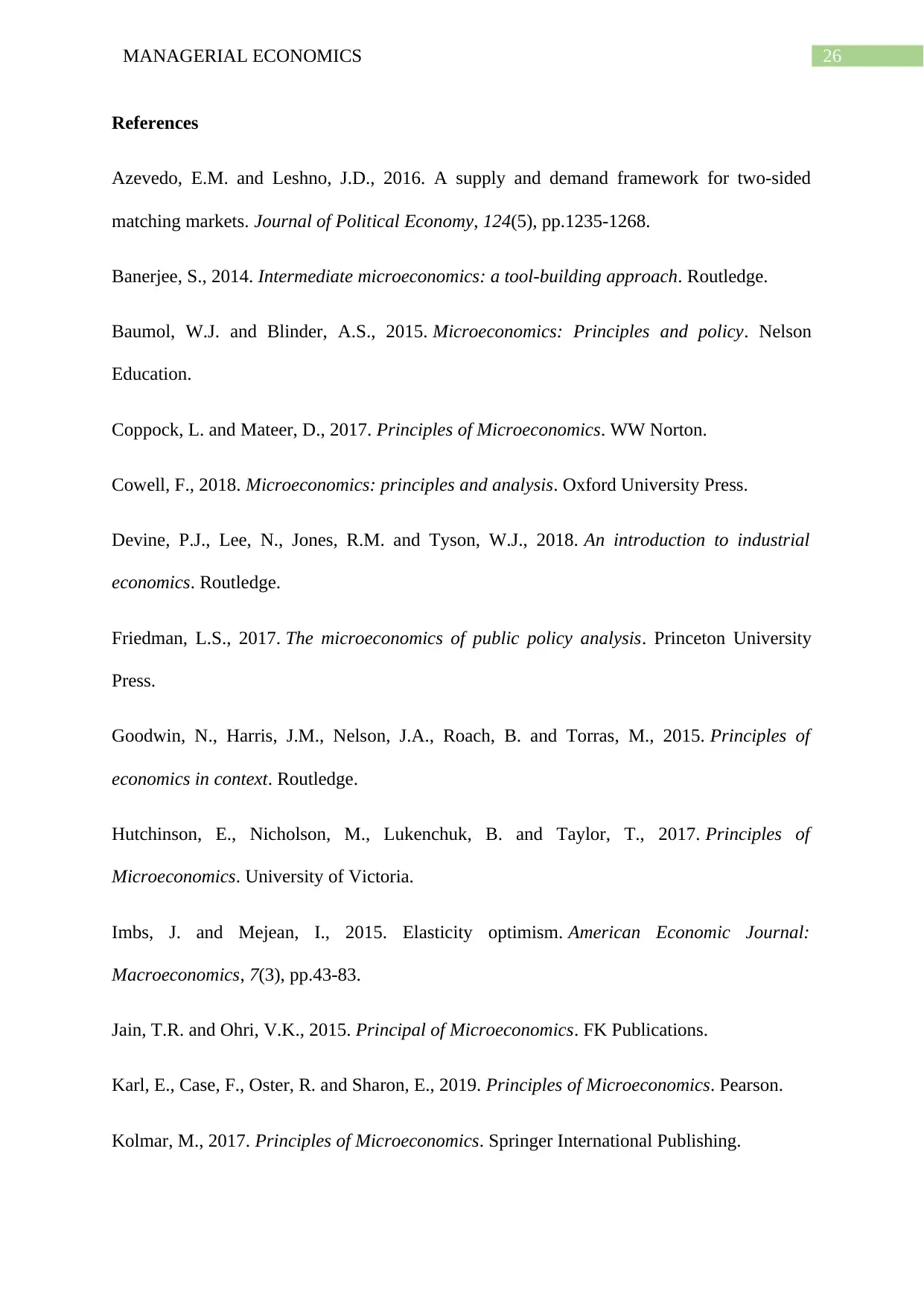
26MANAGERIAL ECONOMICS
References
Azevedo, E.M. and Leshno, J.D., 2016. A supply and demand framework for two-sided
matching markets. Journal of Political Economy, 124(5), pp.1235-1268.
Banerjee, S., 2014. Intermediate microeconomics: a tool-building approach. Routledge.
Baumol, W.J. and Blinder, A.S., 2015. Microeconomics: Principles and policy. Nelson
Education.
Coppock, L. and Mateer, D., 2017. Principles of Microeconomics. WW Norton.
Cowell, F., 2018. Microeconomics: principles and analysis. Oxford University Press.
Devine, P.J., Lee, N., Jones, R.M. and Tyson, W.J., 2018. An introduction to industrial
economics. Routledge.
Friedman, L.S., 2017. The microeconomics of public policy analysis. Princeton University
Press.
Goodwin, N., Harris, J.M., Nelson, J.A., Roach, B. and Torras, M., 2015. Principles of
economics in context. Routledge.
Hutchinson, E., Nicholson, M., Lukenchuk, B. and Taylor, T., 2017. Principles of
Microeconomics. University of Victoria.
Imbs, J. and Mejean, I., 2015. Elasticity optimism. American Economic Journal:
Macroeconomics, 7(3), pp.43-83.
Jain, T.R. and Ohri, V.K., 2015. Principal of Microeconomics. FK Publications.
Karl, E., Case, F., Oster, R. and Sharon, E., 2019. Principles of Microeconomics. Pearson.
Kolmar, M., 2017. Principles of Microeconomics. Springer International Publishing.
References
Azevedo, E.M. and Leshno, J.D., 2016. A supply and demand framework for two-sided
matching markets. Journal of Political Economy, 124(5), pp.1235-1268.
Banerjee, S., 2014. Intermediate microeconomics: a tool-building approach. Routledge.
Baumol, W.J. and Blinder, A.S., 2015. Microeconomics: Principles and policy. Nelson
Education.
Coppock, L. and Mateer, D., 2017. Principles of Microeconomics. WW Norton.
Cowell, F., 2018. Microeconomics: principles and analysis. Oxford University Press.
Devine, P.J., Lee, N., Jones, R.M. and Tyson, W.J., 2018. An introduction to industrial
economics. Routledge.
Friedman, L.S., 2017. The microeconomics of public policy analysis. Princeton University
Press.
Goodwin, N., Harris, J.M., Nelson, J.A., Roach, B. and Torras, M., 2015. Principles of
economics in context. Routledge.
Hutchinson, E., Nicholson, M., Lukenchuk, B. and Taylor, T., 2017. Principles of
Microeconomics. University of Victoria.
Imbs, J. and Mejean, I., 2015. Elasticity optimism. American Economic Journal:
Macroeconomics, 7(3), pp.43-83.
Jain, T.R. and Ohri, V.K., 2015. Principal of Microeconomics. FK Publications.
Karl, E., Case, F., Oster, R. and Sharon, E., 2019. Principles of Microeconomics. Pearson.
Kolmar, M., 2017. Principles of Microeconomics. Springer International Publishing.
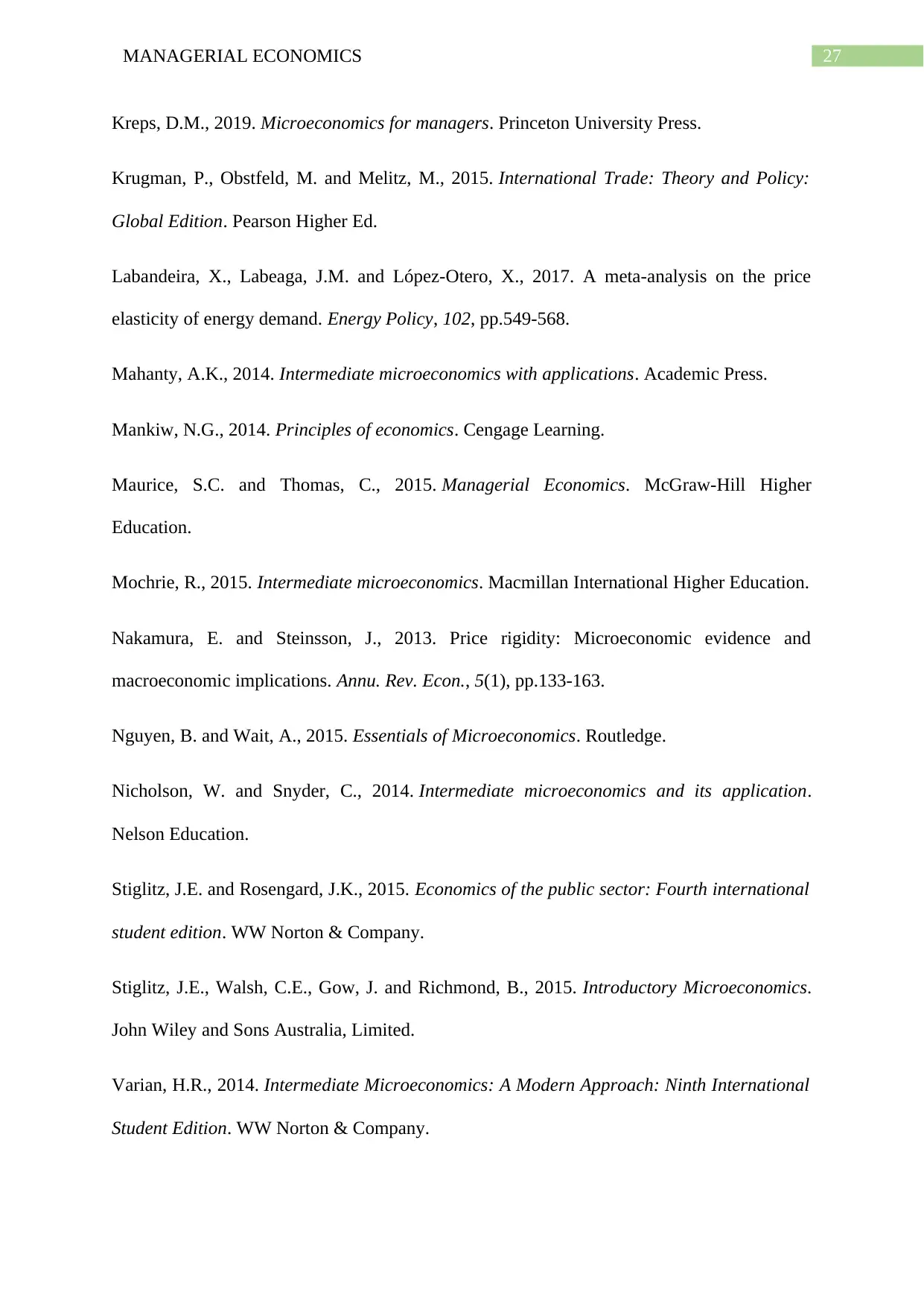
27MANAGERIAL ECONOMICS
Kreps, D.M., 2019. Microeconomics for managers. Princeton University Press.
Krugman, P., Obstfeld, M. and Melitz, M., 2015. International Trade: Theory and Policy:
Global Edition. Pearson Higher Ed.
Labandeira, X., Labeaga, J.M. and López-Otero, X., 2017. A meta-analysis on the price
elasticity of energy demand. Energy Policy, 102, pp.549-568.
Mahanty, A.K., 2014. Intermediate microeconomics with applications. Academic Press.
Mankiw, N.G., 2014. Principles of economics. Cengage Learning.
Maurice, S.C. and Thomas, C., 2015. Managerial Economics. McGraw-Hill Higher
Education.
Mochrie, R., 2015. Intermediate microeconomics. Macmillan International Higher Education.
Nakamura, E. and Steinsson, J., 2013. Price rigidity: Microeconomic evidence and
macroeconomic implications. Annu. Rev. Econ., 5(1), pp.133-163.
Nguyen, B. and Wait, A., 2015. Essentials of Microeconomics. Routledge.
Nicholson, W. and Snyder, C., 2014. Intermediate microeconomics and its application.
Nelson Education.
Stiglitz, J.E. and Rosengard, J.K., 2015. Economics of the public sector: Fourth international
student edition. WW Norton & Company.
Stiglitz, J.E., Walsh, C.E., Gow, J. and Richmond, B., 2015. Introductory Microeconomics.
John Wiley and Sons Australia, Limited.
Varian, H.R., 2014. Intermediate Microeconomics: A Modern Approach: Ninth International
Student Edition. WW Norton & Company.
Kreps, D.M., 2019. Microeconomics for managers. Princeton University Press.
Krugman, P., Obstfeld, M. and Melitz, M., 2015. International Trade: Theory and Policy:
Global Edition. Pearson Higher Ed.
Labandeira, X., Labeaga, J.M. and López-Otero, X., 2017. A meta-analysis on the price
elasticity of energy demand. Energy Policy, 102, pp.549-568.
Mahanty, A.K., 2014. Intermediate microeconomics with applications. Academic Press.
Mankiw, N.G., 2014. Principles of economics. Cengage Learning.
Maurice, S.C. and Thomas, C., 2015. Managerial Economics. McGraw-Hill Higher
Education.
Mochrie, R., 2015. Intermediate microeconomics. Macmillan International Higher Education.
Nakamura, E. and Steinsson, J., 2013. Price rigidity: Microeconomic evidence and
macroeconomic implications. Annu. Rev. Econ., 5(1), pp.133-163.
Nguyen, B. and Wait, A., 2015. Essentials of Microeconomics. Routledge.
Nicholson, W. and Snyder, C., 2014. Intermediate microeconomics and its application.
Nelson Education.
Stiglitz, J.E. and Rosengard, J.K., 2015. Economics of the public sector: Fourth international
student edition. WW Norton & Company.
Stiglitz, J.E., Walsh, C.E., Gow, J. and Richmond, B., 2015. Introductory Microeconomics.
John Wiley and Sons Australia, Limited.
Varian, H.R., 2014. Intermediate Microeconomics: A Modern Approach: Ninth International
Student Edition. WW Norton & Company.
Secure Best Marks with AI Grader
Need help grading? Try our AI Grader for instant feedback on your assignments.
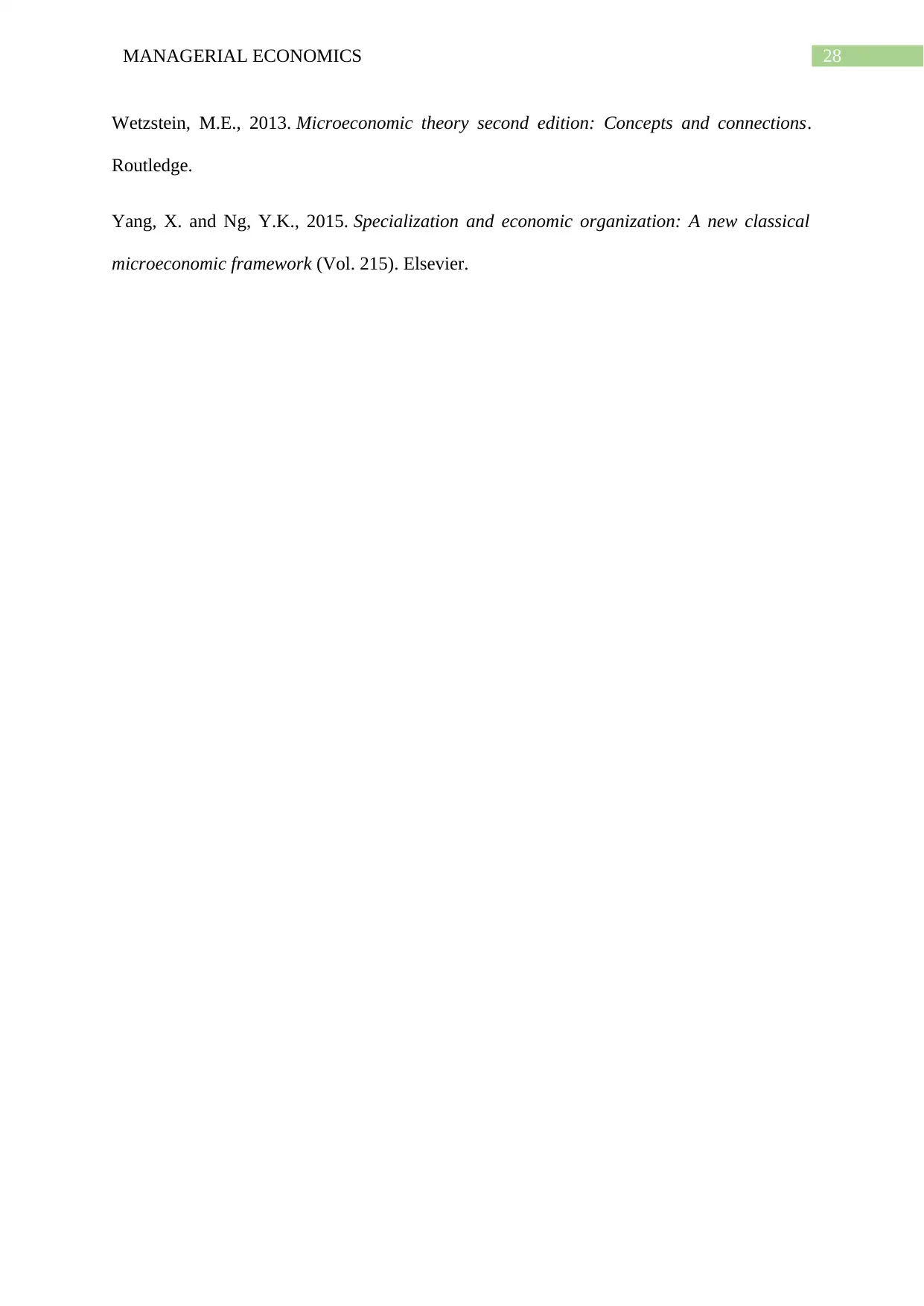
28MANAGERIAL ECONOMICS
Wetzstein, M.E., 2013. Microeconomic theory second edition: Concepts and connections.
Routledge.
Yang, X. and Ng, Y.K., 2015. Specialization and economic organization: A new classical
microeconomic framework (Vol. 215). Elsevier.
Wetzstein, M.E., 2013. Microeconomic theory second edition: Concepts and connections.
Routledge.
Yang, X. and Ng, Y.K., 2015. Specialization and economic organization: A new classical
microeconomic framework (Vol. 215). Elsevier.
1 out of 29
Related Documents
Your All-in-One AI-Powered Toolkit for Academic Success.
+13062052269
info@desklib.com
Available 24*7 on WhatsApp / Email
![[object Object]](/_next/static/media/star-bottom.7253800d.svg)
Unlock your academic potential
© 2024 | Zucol Services PVT LTD | All rights reserved.





